Affiliate link disclosure – The BMW Repair Guide uses affiliate links in their site. For more information on affiliate links, please click here.
Repair Summary
The following article gives detailed instructions on replacing the transmission solenoids in a ZF 6HP-19X six speed automatic transmission. Even though we have used a 2006 BMW 530xi to perform this repair, this article can be applied to any vehicle with the ZF 6HP six speed automatic transmission with minor modifications.
See all vehicles this article applies to
E60 5 Series M5
E60 5 Series 523Li
E60 5 Series 550i
E60 5 Series 545i
E60 5 Series 540i
E60 5 Series 535d
E60 5 Series 530xi
E60 5 Series 530xd
E60 5 Series 530Li
E60 5 Series 530i
E60 5 Series 530d
E60 5 Series 525i
E60 5 Series 525xi
E60 5 Series 525Li
E60 5 Series 525d
E60 5 Series 523i
E60 5 Series 520i
E60 5 Series 520d
E60N 5 Series 550i
E60N 5 Series 525xi
E60N 5 Series 540i
E60N 5 Series 535xi
E60N 5 Series 535i
E60N 5 Series 535d
E60N 5 Series 530xi
E60N 5 Series 530xd
E60N 5 Series 530Li
E60N 5 Series 530i
E60N 5 Series 528xi
E60N 5 Series 530d
E60N 5 Series 528i
E60N 5 Series 525Li
E60N 5 Series 525xd
E60N 5 Series 525i
E60N 5 Series 525d
E60N 5 Series 523Li
E60N 5 Series 523i
E60N 5 Series 520Li
E60N 5 Series 520d
E60N 5 Series 520i
E61 5 Series 550i
E61 5 Series 530d
E61 5 Series 545i
E61 5 Series 535d
E61 5 Series 530xi
E61 5 Series 530xd
E61 5 Series 525i
E61 5 Series 530i
E61 5 Series 525xi
E61 5 Series 525d
E61 5 Series 523i
E61 5 Series 520d
A BMW transmission solenoid replacement can help cure high rpm gear change slips, erratic shifting, and the infamous transmission "thumping" sound.
The ZF 6HP six-speed transmission was one of the most popular gearboxes ever produced for passenger cars. It was manufactured from 2000-2014 and was used by many popular U.S. and European automobile brands such as GM, Ford, Audi, Mercedes, and Jaguar...just to name a few. The ZF 6HP is also a BMW workhorse and can be found in most of the models produced throughout the mid to late 2000s including the E60 5 series, E63 6 series, E9x 3 series as well as the X3 and Z4. It is an extremely popular transmission with millions of them still on the road.
It is an inconvenient truth that as these transmissions start to age in our BMWs, they start to malfunction. Internal valve body gaskets and seals start to leak, causing erratic shifting and error codes. One of the most prevalent causes of shifting issues in the ZF six-speed transmission is its electronic solenoids.
The BMW transmission solenoids are attached to the rear of the valve body inside the oil pan. The solenoids are electro-hydraulic valves that control the flow of pressurized fluid through the network of channels in the valve body. As the solenoids open and close the pressurized fluid engages the transmission's clutches, smoothly shifting the gears. Over time the solenoids can become clogged with dirt from old transmission fluid, causing them to stick in the open or closed position. Their internal electronic components can also fail over time, making them inoperable. Either condition can wreak havoc on the performance of the transmission.
The most common symptom of a failed BMW transmission solenoid is gear change slippage at higher RPMs. Other symptoms may also include erratic, delayed, or rough shifting and the infamous transmission "thump" that occurs when shifting into reverse or while decelerating during driving.
The BMW Repair Guide strongly recommends replacing the valve body sealing sleeves and adapter while doing this repair. For more information on how to replace the sealing sleeves and adapter, please see our article BMW Mechatronics Sealing Sleeves and Adapter Repair.



View the detailed parts diagram for this repair.
Includes detailed part diagrams, part numbers and links to purchase all of the required components needed to complete this repair.

Before starting this repair, you must have the following required parts.
All BMW vehicles with the ZF GA6HP19Z transmission
These are the factory replacement solenoids for the ZF 6HP-19X six speed transmissions.
All BMW vehicles with the ZF GA6HP19Z transmission
It is good practice to always replace your transmission oil pan gasket when the pan is removed for repairs or service work. A new oil pan gasket is cheap insurance against those annoying transmission leaks that puddle on your garage floor.
For use in all BMW 6 speed transmissions
ZF Lifeguard 6 is the original fluid that your BMW's 6 speed transmission was manufactured and shipped with. It is for use in all 6 speed ZF transmissions. It meets Shell M1375.4 specifications. Acceptable for use in all BMW vehicles with a six speed ZF transmission.
For use in all BMW 6 speed transmissions
This is the Genuine BMW ATF2 "Gold Fluid". It is the same factory transmission fluid that is used at the BMW dealership to service your vehicle. For use in all 6 speed ZF transmissions, meets Shell M1375.4 specifications. Acceptable for use in all BMW vehicles with a 6 speed ZF transmission.
For use in all BMW 5 and 6 speed transmissions
Red Line has a reputation with racers and enthusiasts alike for creating products that perform and protect better than any on the market. Redline D4 is a fully synthetic oil that ensures proper shifting while providing ultimate wear protection. For use in all 5 and 6 speed ZF and GM transmissions, meets Shell M1375.4 specifications.
Fits all BMW vehicles with the ZF 6HP-19X transmission.
This plug is located in the bottom of the transmission, in the transmission pan.
Commonly used in many different models.
This is the same factory part installed at the BMW dealership. Includes rubber sealing o-ring.
All BMW vehicles with the ZF GA6HP19Z transmission
The electrical connection sealing sleeve prevents transmission fluid from leaking out of the rear of the gear box where the electrical plug attaches to the valve body. Heat and age can cause the sleeve to warp, allowing gearbox oil to seep by its o-rings.
Section 1 - Removing the Transmission Oil Pan
The vehicle's transmission oil pan must be removed to perform a BMW transmission solenoid replacement. There is a slight variation in the instructions when draining the transmission in an xDrive BMW versus a rear-wheel-drive model. The difference is in accessing the transmission fluid fill plug. Unfortunately in xDrive model vehicles, the front driveshaft blocks access to the fill plug, requiring the shaft to be unbolted from the transfer case and swiveled out of the way (see images below). Since there is no front driveshaft in rear-wheel-drive models, there is clear access to the fill plug and no extra steps are needed. We give instructions below on how to remove the fill plug in both models.- Jack and support your car at all four wheels using wheel ramps or stands. The BMW Repair Guide does not recommend using jack stands to support your vehicle unless the wheels need to be removed for the repair. For more information on jacking and supporting your vehicle, please see our article BMW Jacking and Supporting for Repairs and Maintenance.
- Remove the engine (front) belly pan. This step differs among BMW models, but usually requires removing phillips heads screws like shown on the E61 touring wagon.
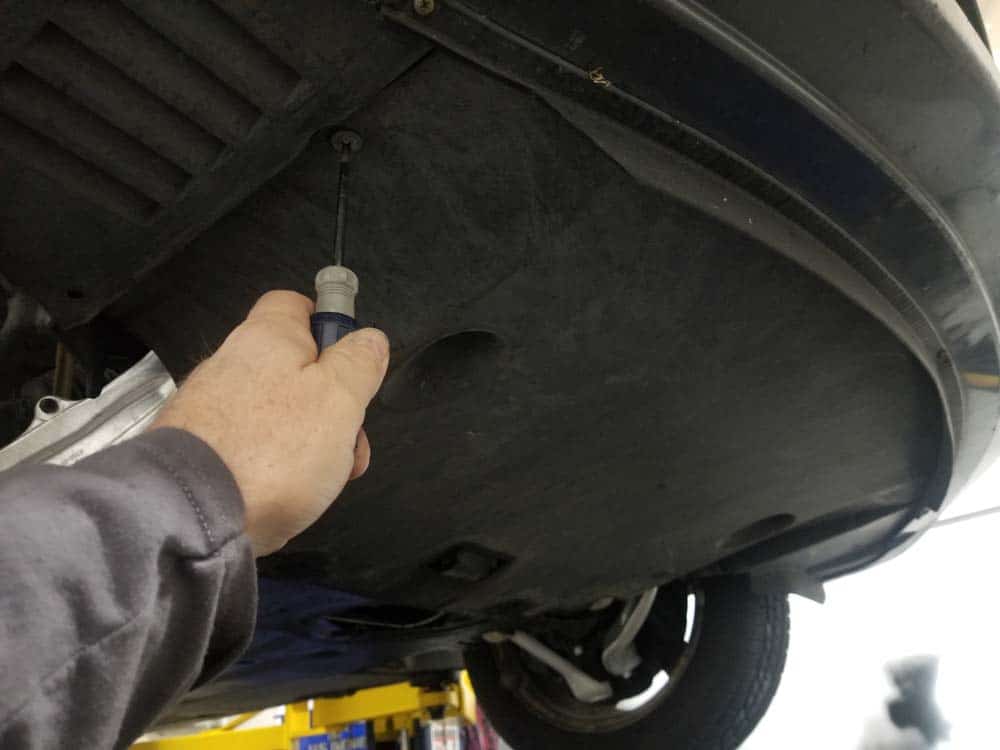
- Remove the underfloor (rear) belly pan from the bottom of the car.
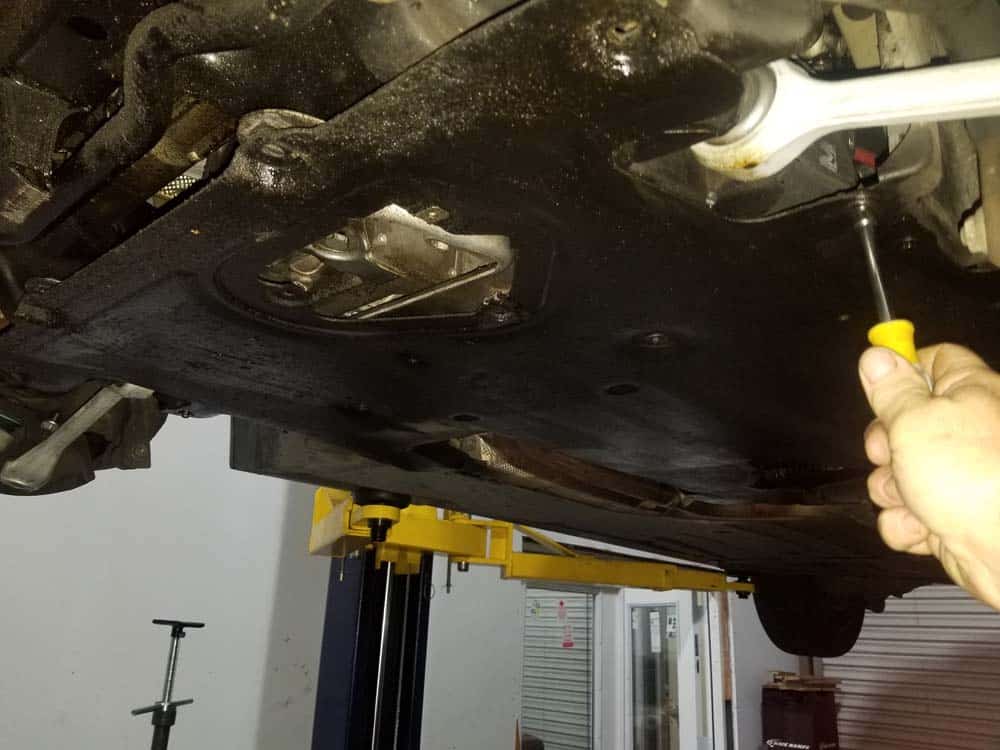
- Locate the transmission oil pan cover, approximately in the middle of the vehicle.
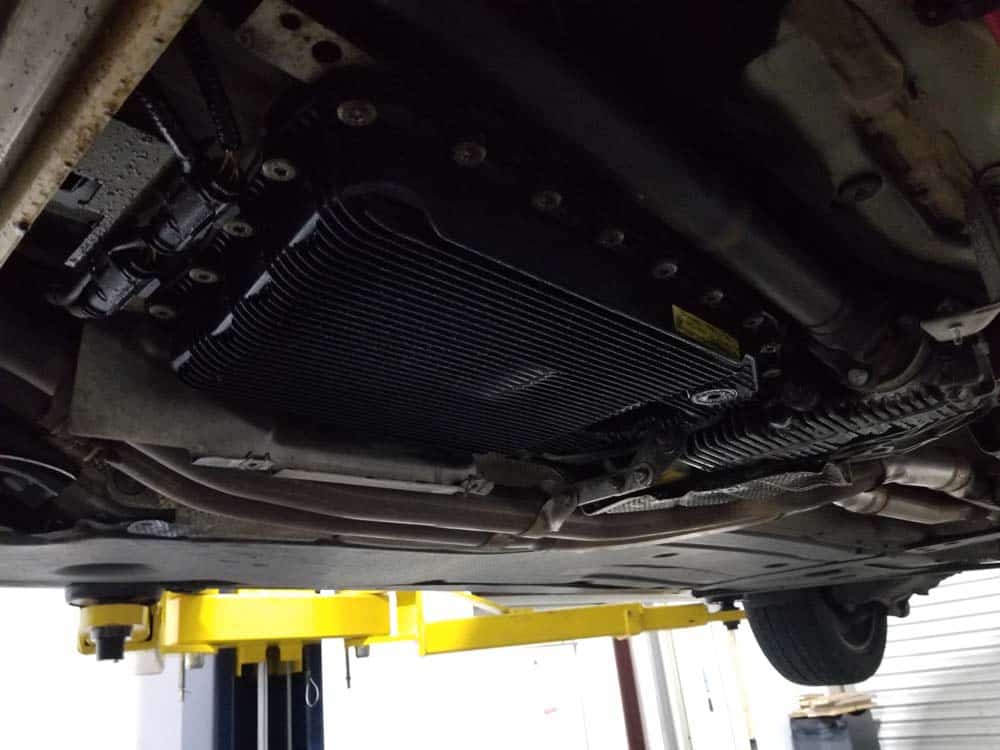
- Before draining the transmission, always loosen the fill plug first. Never attempt to drain the transmission until you have successfully loosened the fill plug. You do not want to find out after you drained the transmission that the fill plug is stuck and you cannot refill the pan.
- The fill plug on BMW six speed transmissions is located on the left upper rear of the gear box...above the oil pan. As discussed at the beginning of this section, xDrive cars require the removal of the front drive shaft to access the plug.
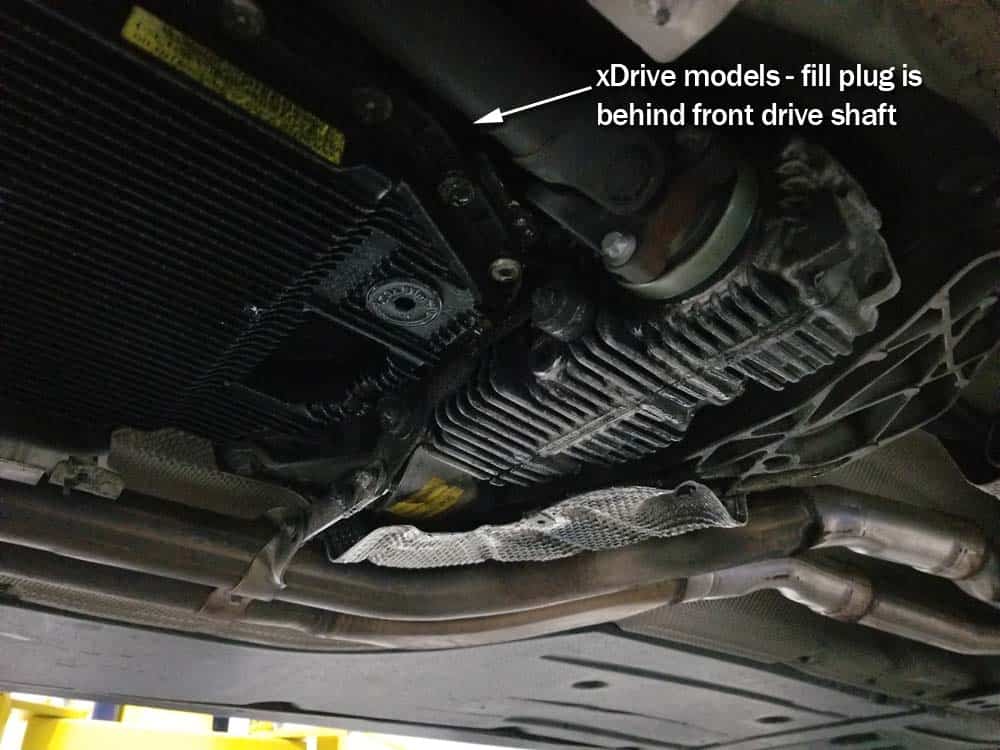
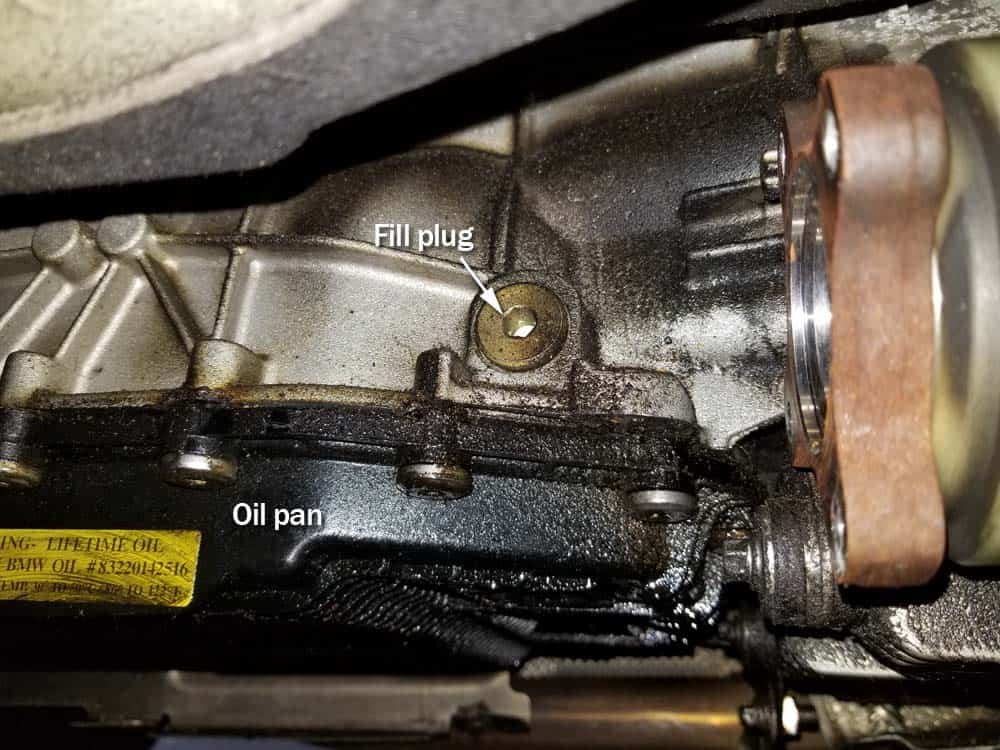
- XDrive "all wheel drive" models - Locate the front drive shaft where it is mounted to the transfer case. Using an E12 external torx socket, remove the four bolts anchoring the front drive shaft to the transfer case. If the wheels of the vehicle are off of the ground (and you are not using an impact wrench), you will need to find a helper to depress the brake pedal while you remove the bolts - otherwise the shaft will just spin freely. Grasp the drive shaft and gently lower it from the transfer case. You can now easily access the fill plug at the rear of the transmission.
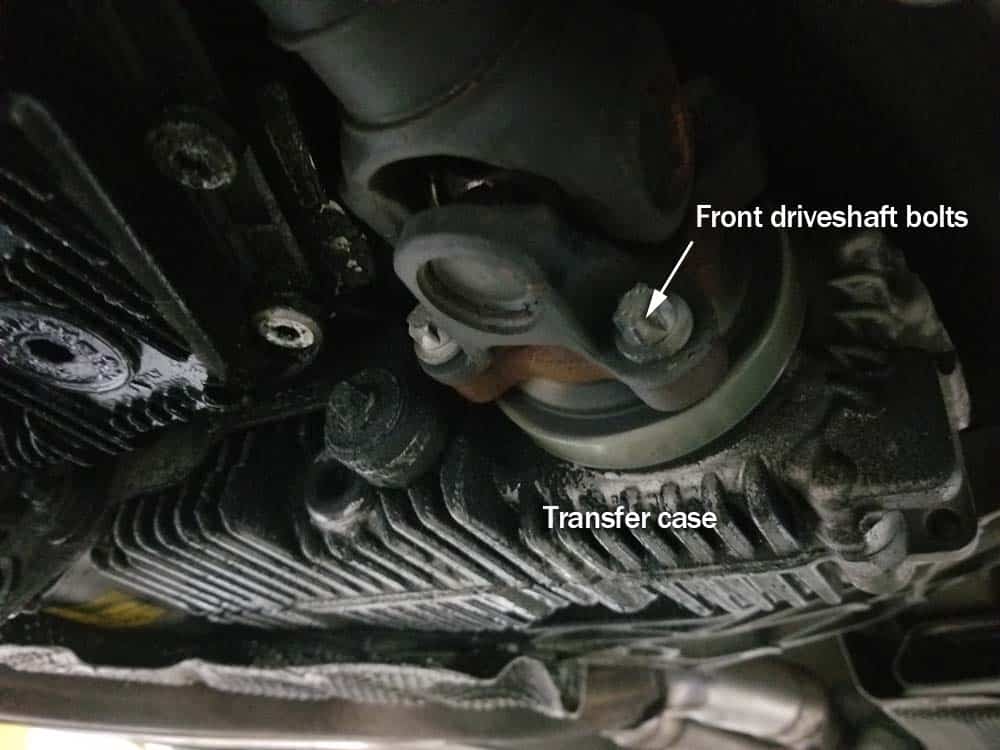
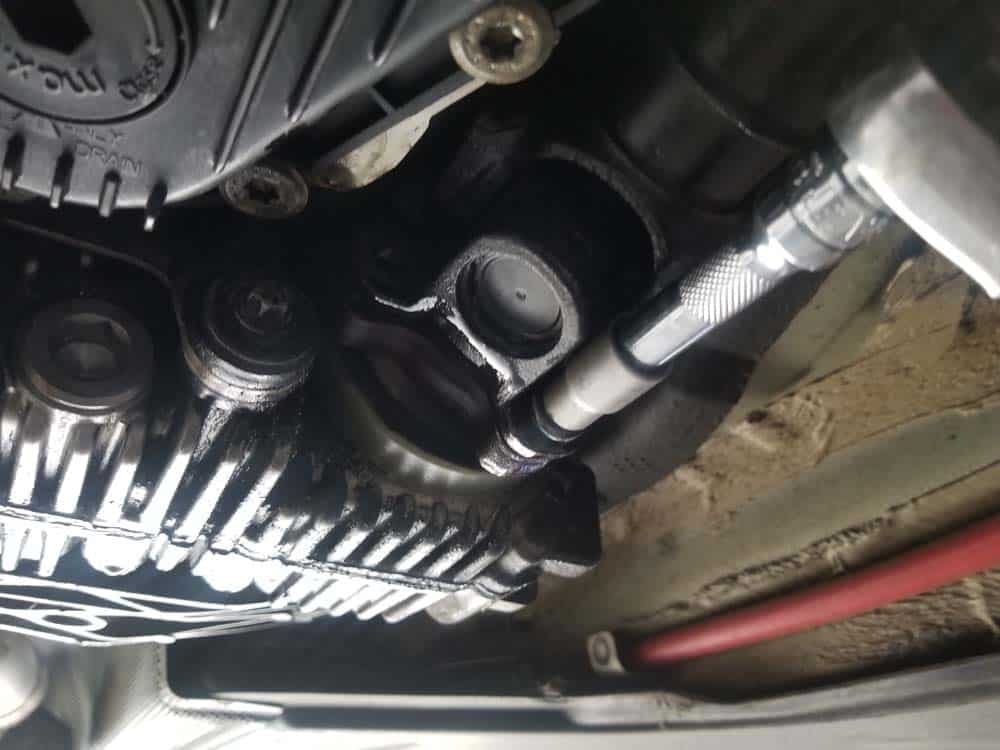
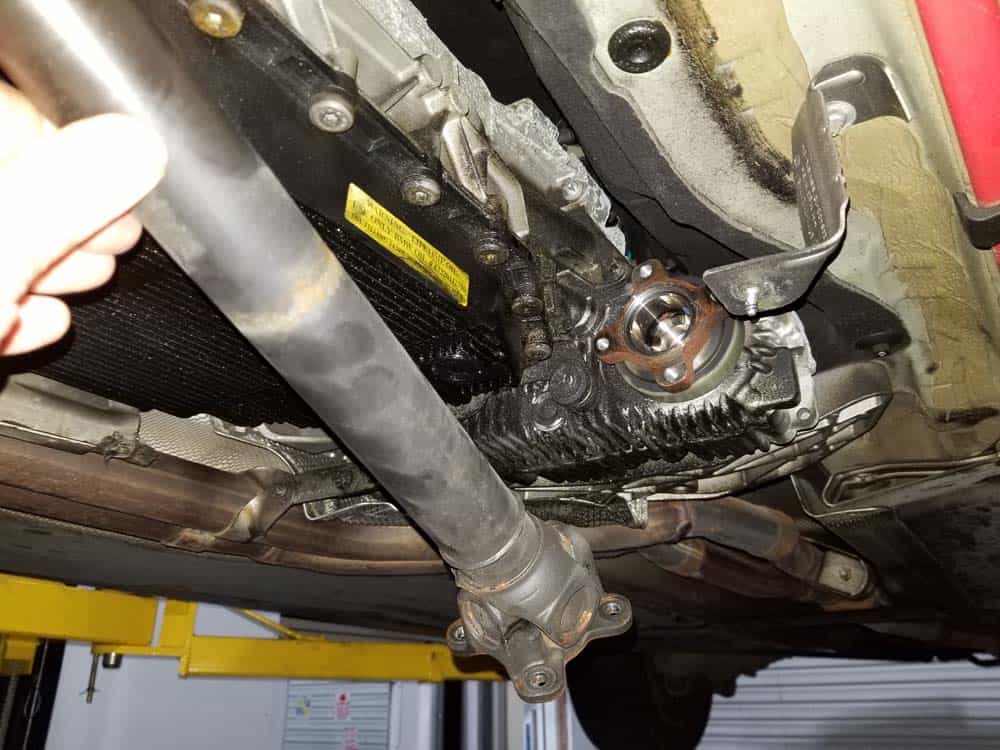
- Rear wheel drive models - Locate the fill plug at the left upper rear of the transmission as shown in the step 6 image above.
- Using a T50 torx bit and a breaker bar, loosen the plug but do not remove it. DO NOT REMOVE THE PLUG. Removing the plug will cause fluid to pour out. You simply want to break it free and confirm that it can be removed during the filling process below.
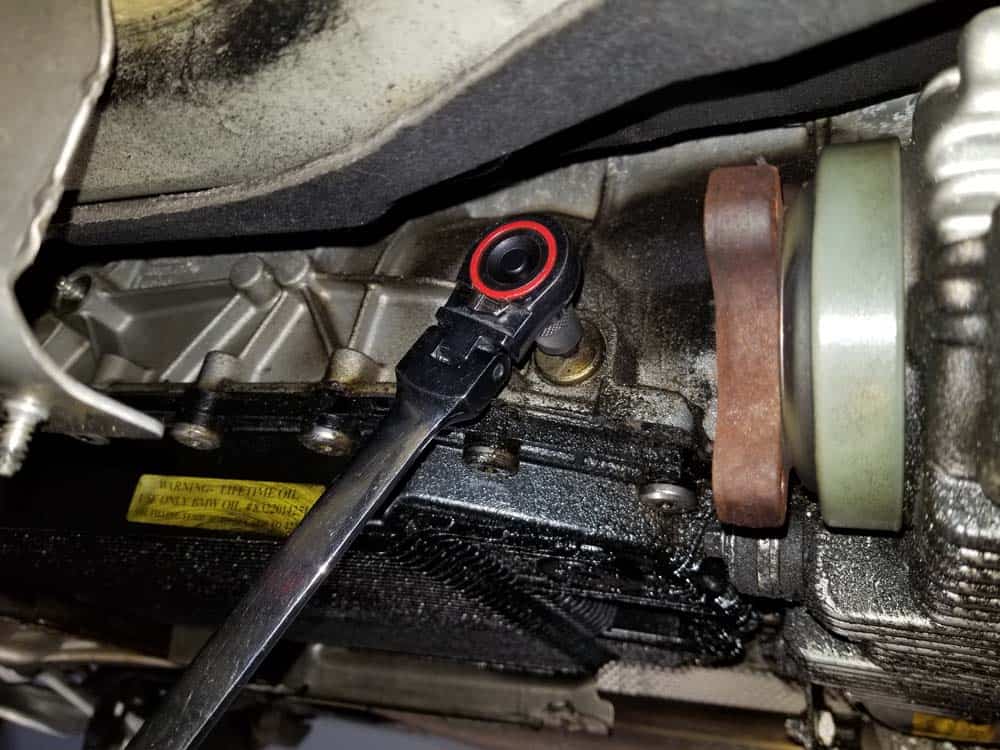
- Position a 5 gallon drain pan under the transmission. Locate the drain plug on the bottom of the oil pan. Using a T50 torx bit, remove the drain plug and allow the pan to thoroughly drain.
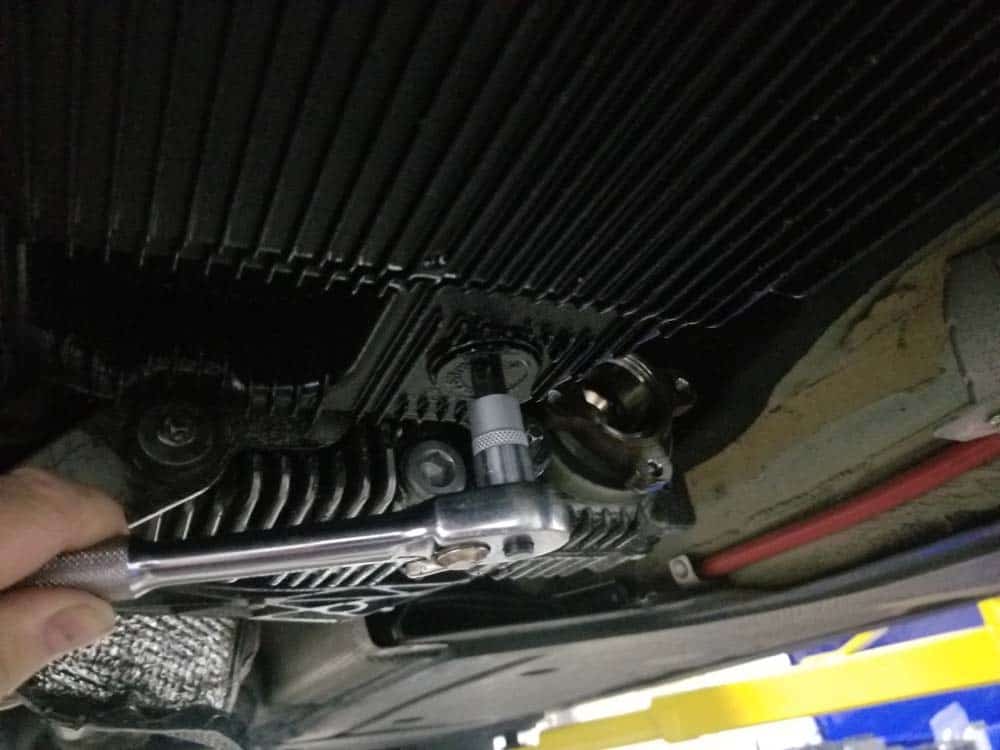

- When the oil pan has completely drained replace the plug. There is still a little bit of oil left in the pan...replacing the plug will keep it from draining on the floor (and on you) when the pan is removed.
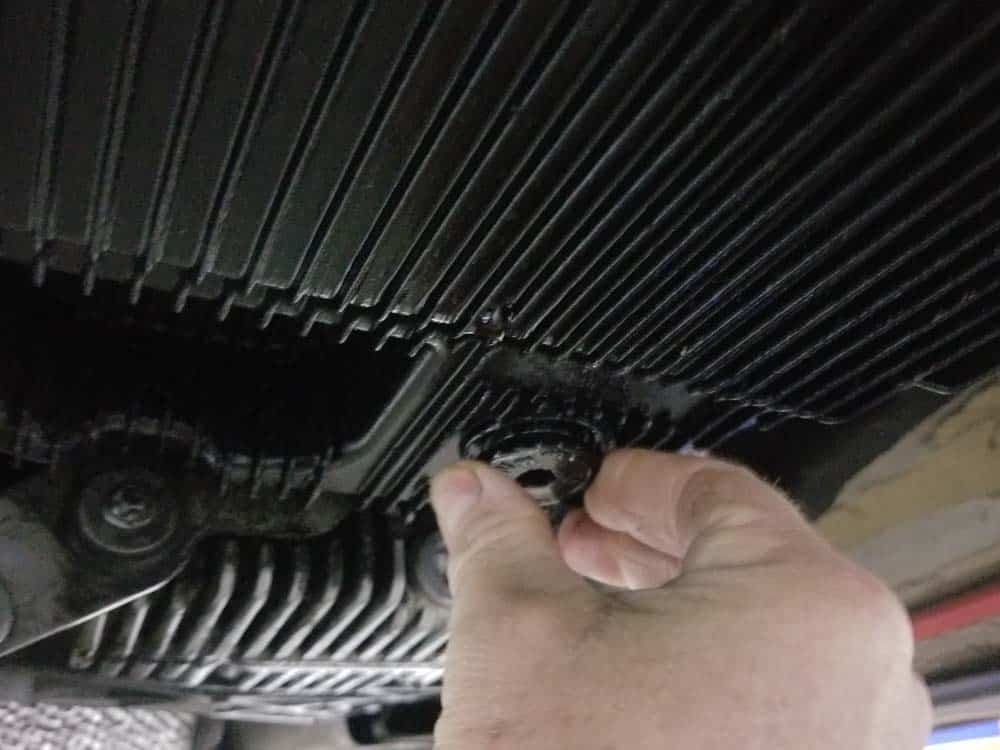
- Using a T40 torx bit, remove the 24 oil pan bolts. The oil pan bolts are at a very low torque, so they should come out easily. It is perfectly acceptable to reuse the oil pan bolts if they are in good condition. If for some reason you have to replace one (which rarely happens), you can reorder replacement bolts by clicking here.
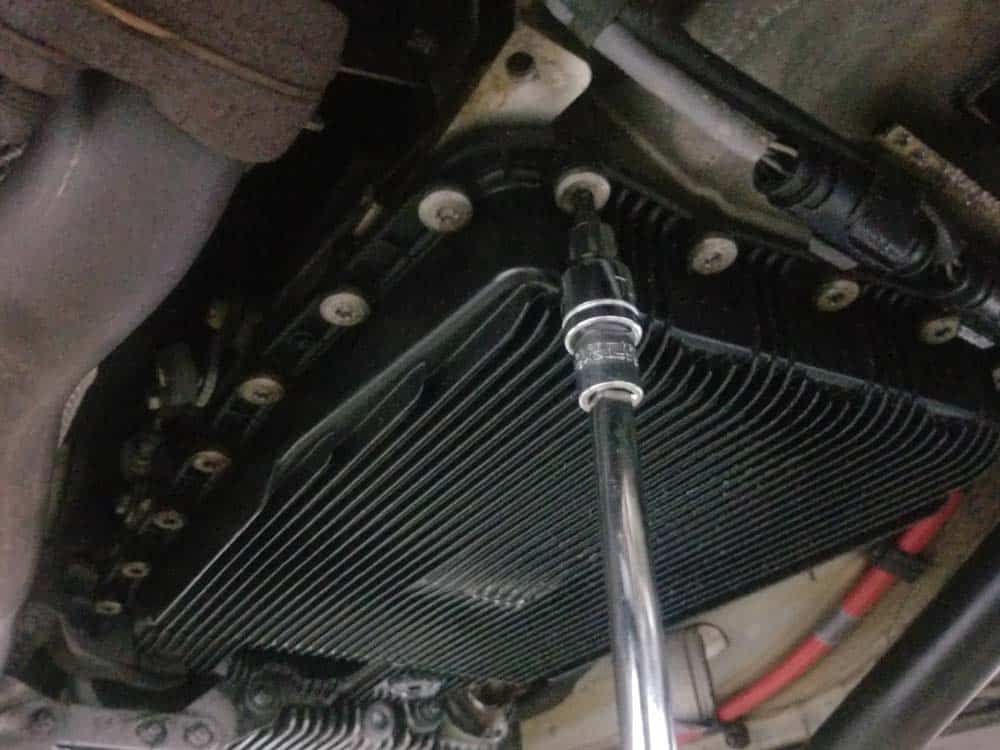
- Grasp the oil pan and carefully remove from the car. Remember the pan still has quite a bit of oil left in it. Dump the remainder of the oil in a drain pan.
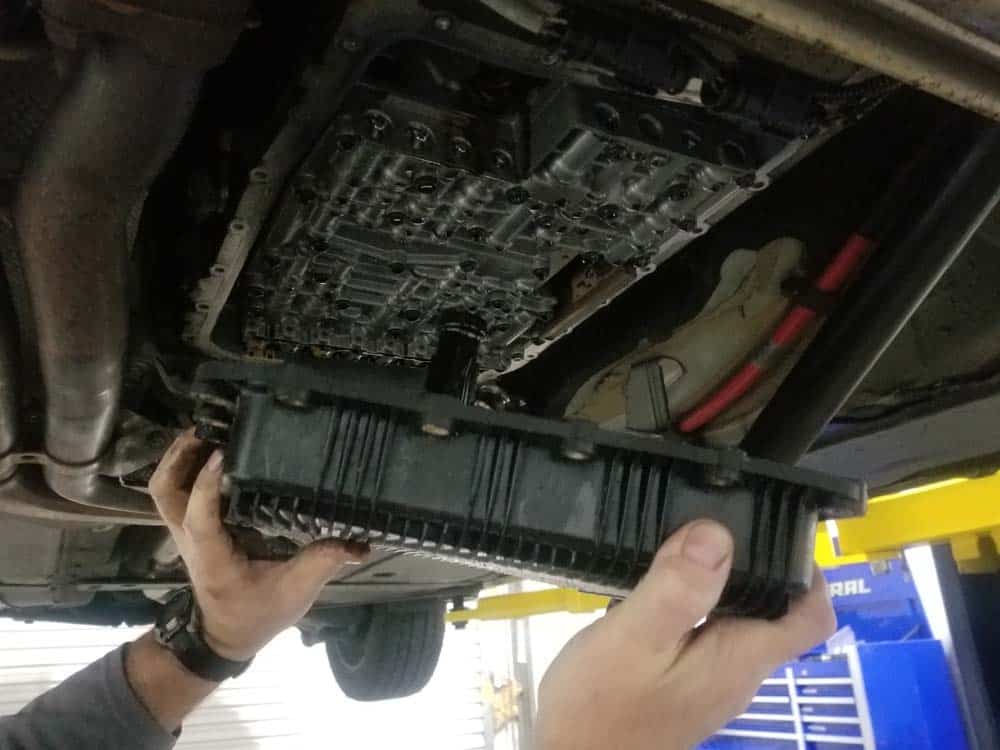
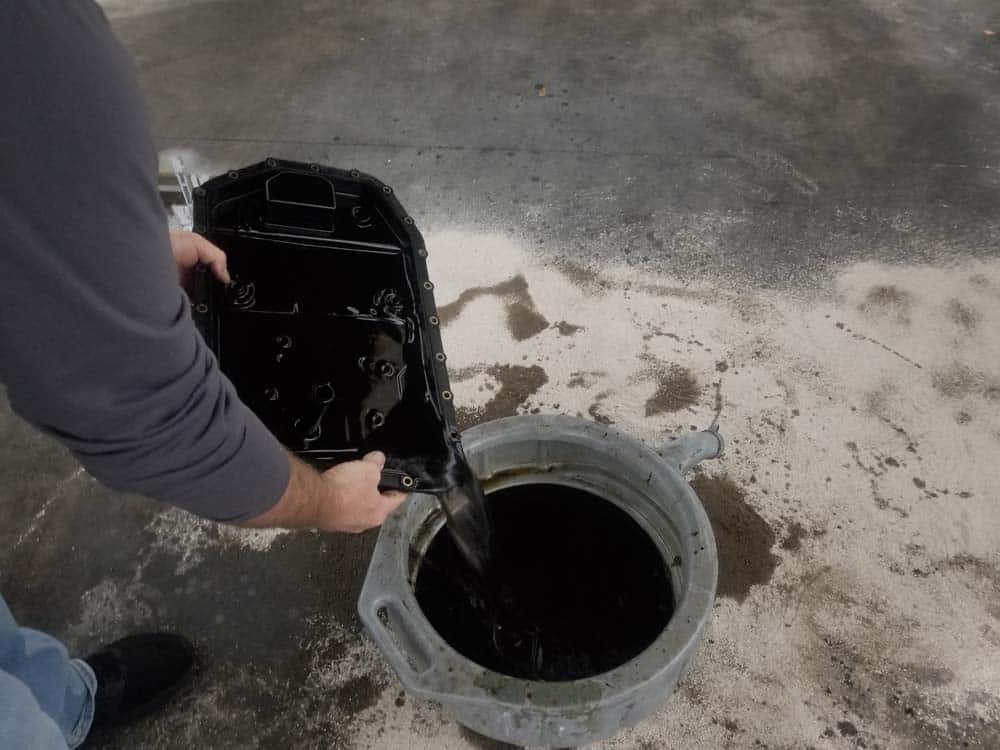
Section 2 - Removing the Mechatronics (valve body) from the Transmission
Be careful when removing the valve body from the transmission housing...dropping it can cause irreversible damage and will have you searching for a new replacement.- Identify the transmission valve body attached to the bottom of the transmission housing.
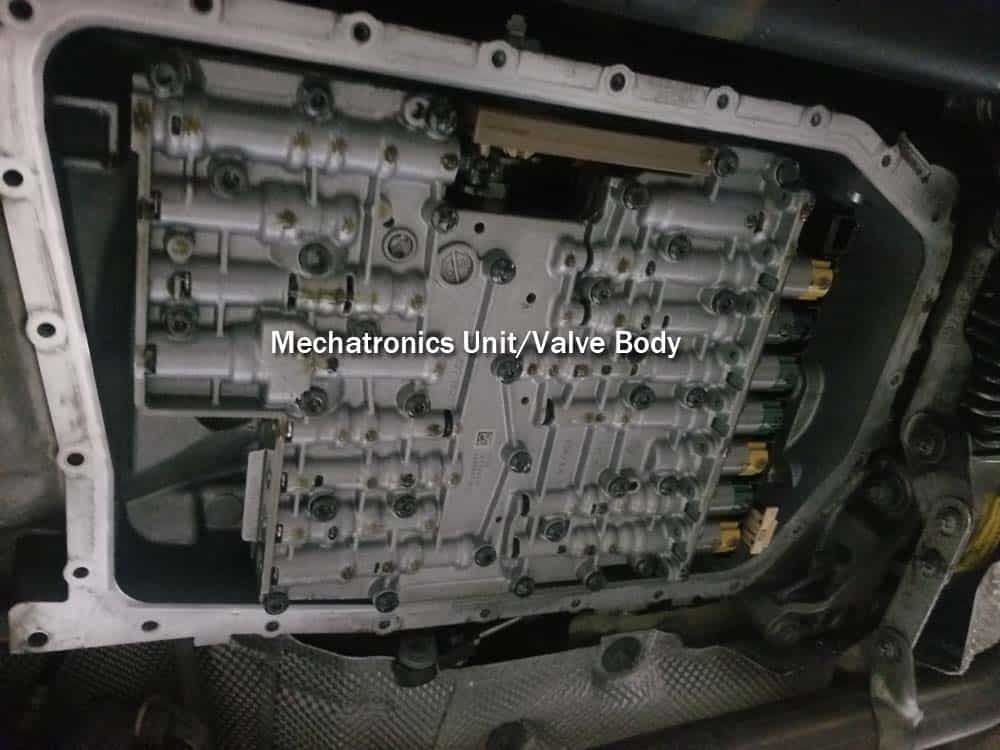
- Reach up behind the right rear of the transmission and release the electrical plug from the valve body by turning its locking ring counterclockwise. Sometimes this ring can get stuck...use a large flat blade screwdriver to turn it if necessary. Pull the plug free from the transmission.
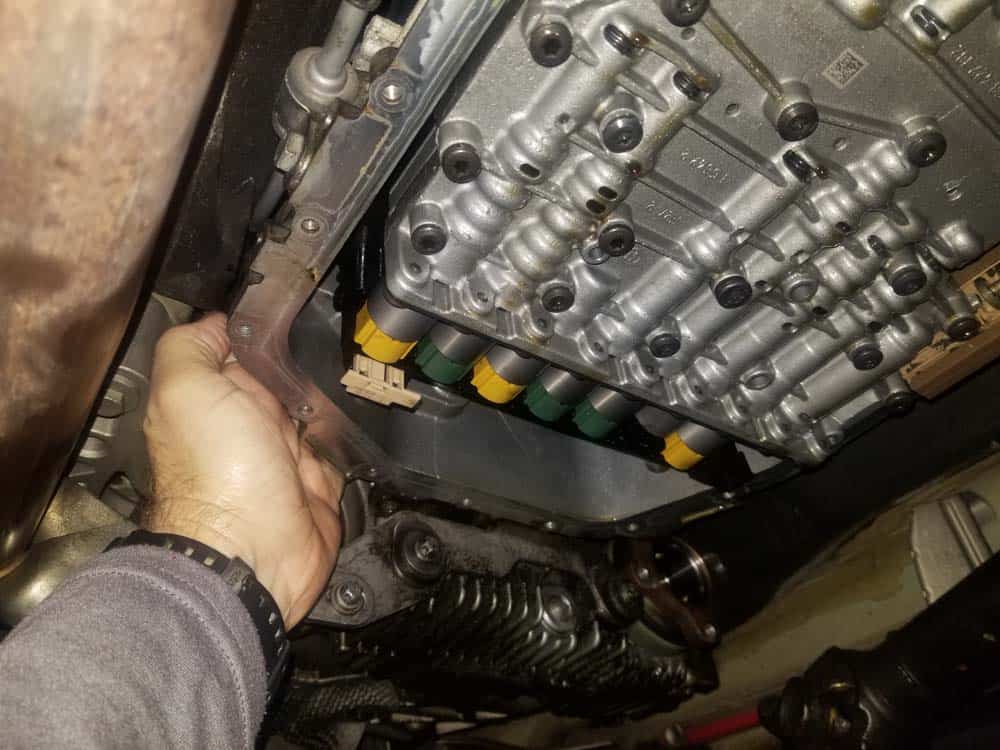
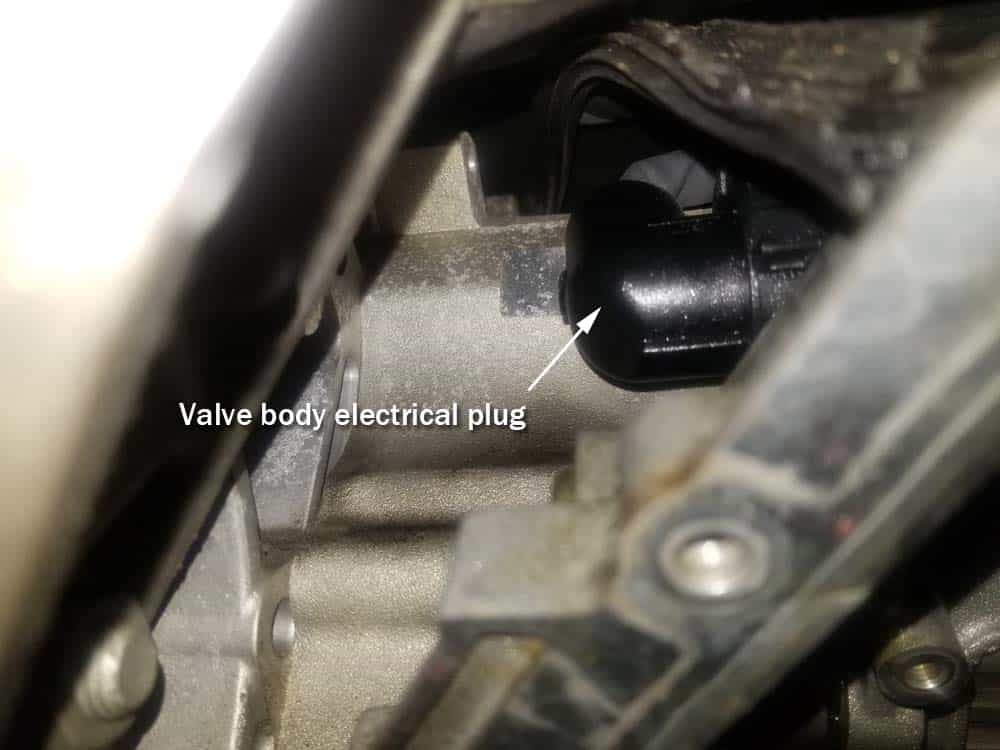
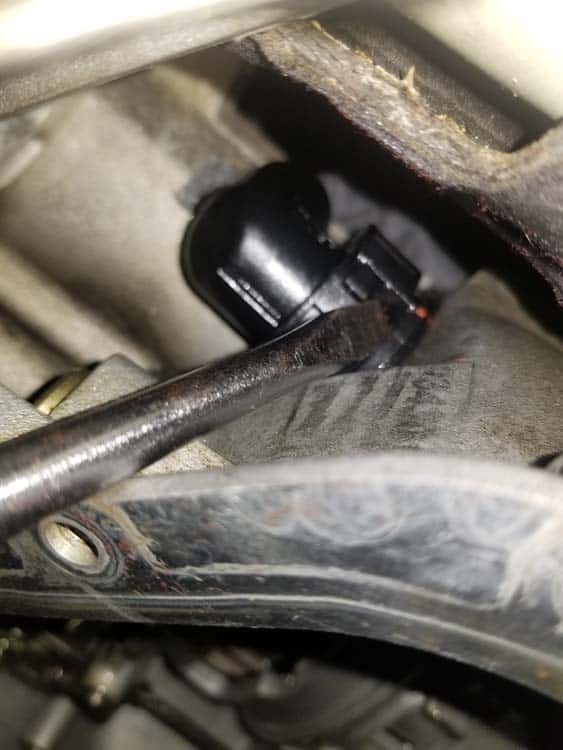
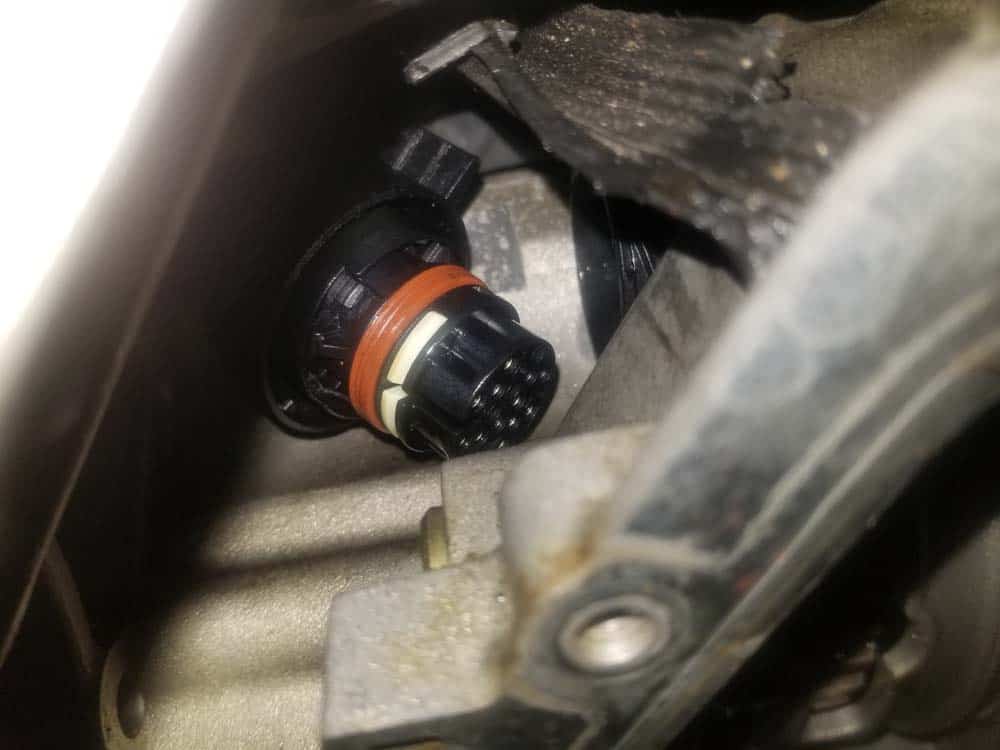
- Release the electrical connector sleeve locking mechanism on the back of the valve body by pulling it down.
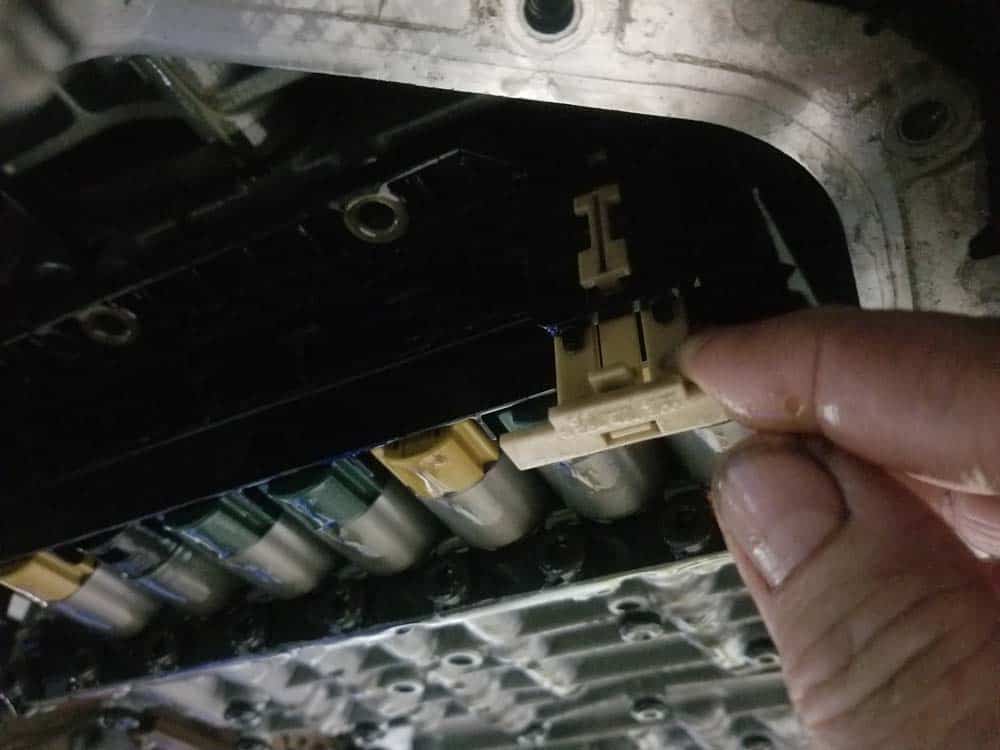
- Reach up behind the transmission again and pull the sleeve out of the valve body and remove from the vehicle. Please note that removing the sleeve from the car on xDrive models can be a little tricky because of the transfer case...take your time, it will come out.
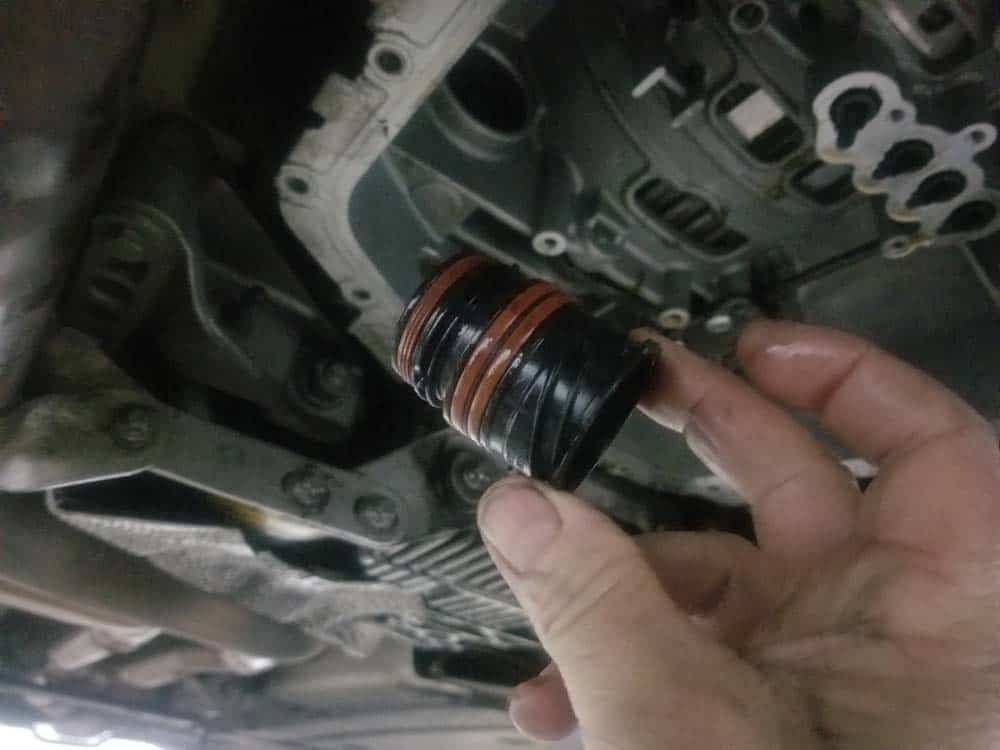
- Remove the ten T40 bolts securing the valve body to the transmission. There are seven in the front and three in the rear as shown in the diagram below. Make sure to hold the valve body as you remove the last bolt. Dropping the valve body can cause severe damage and may require purchasing a new part.
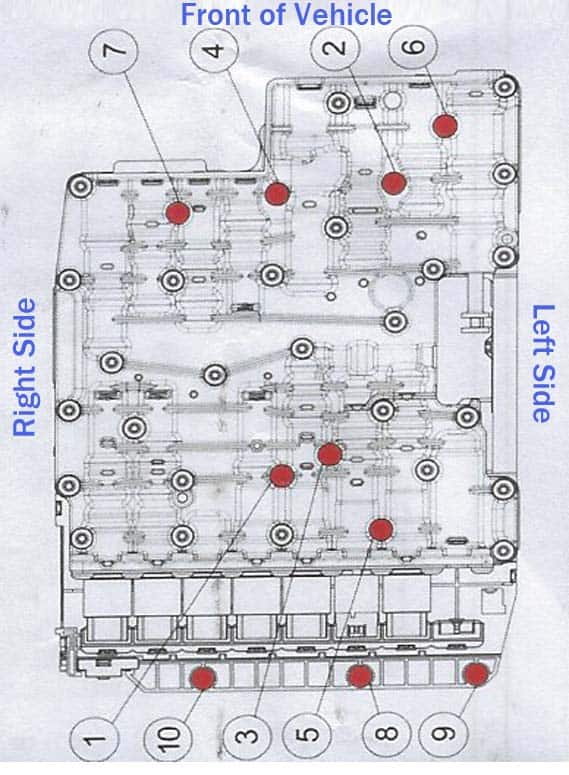
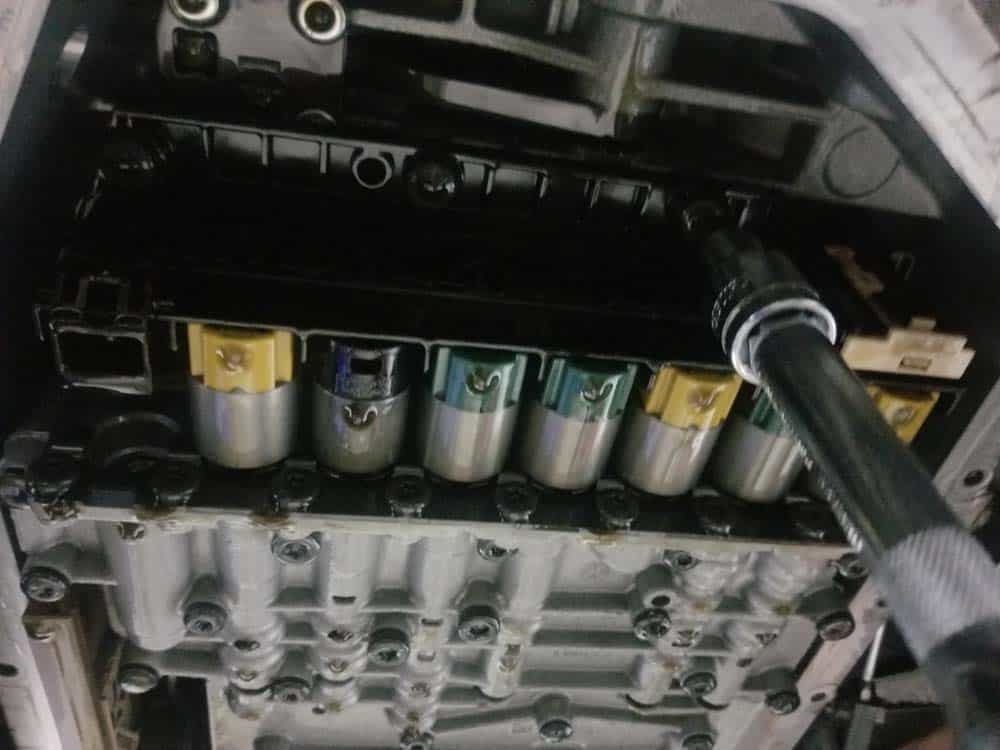
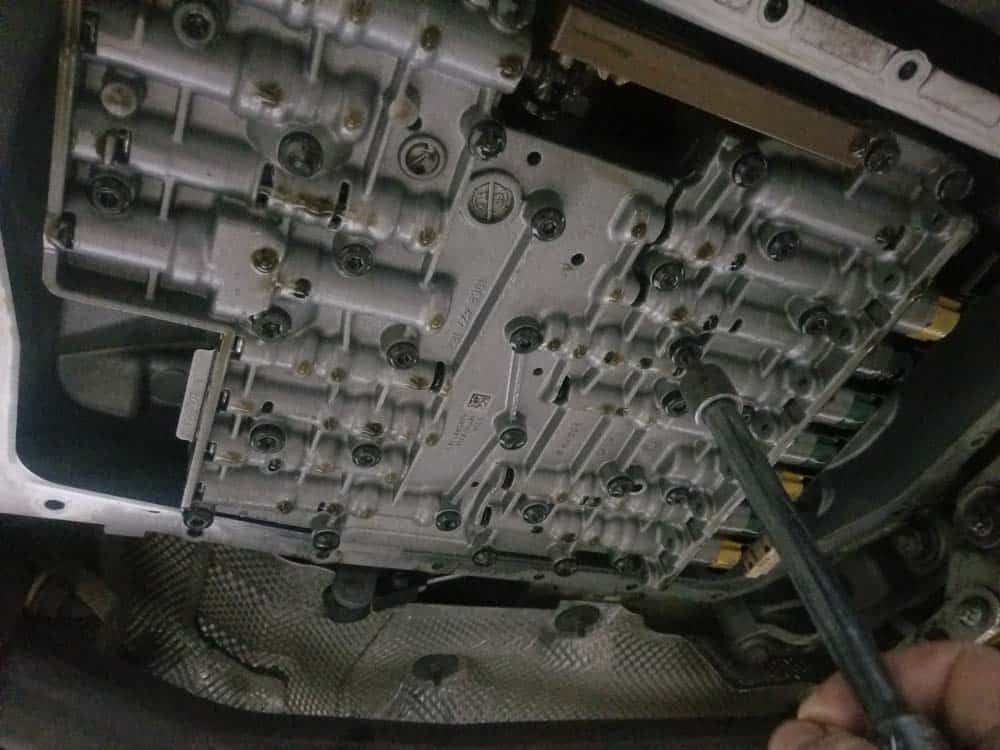
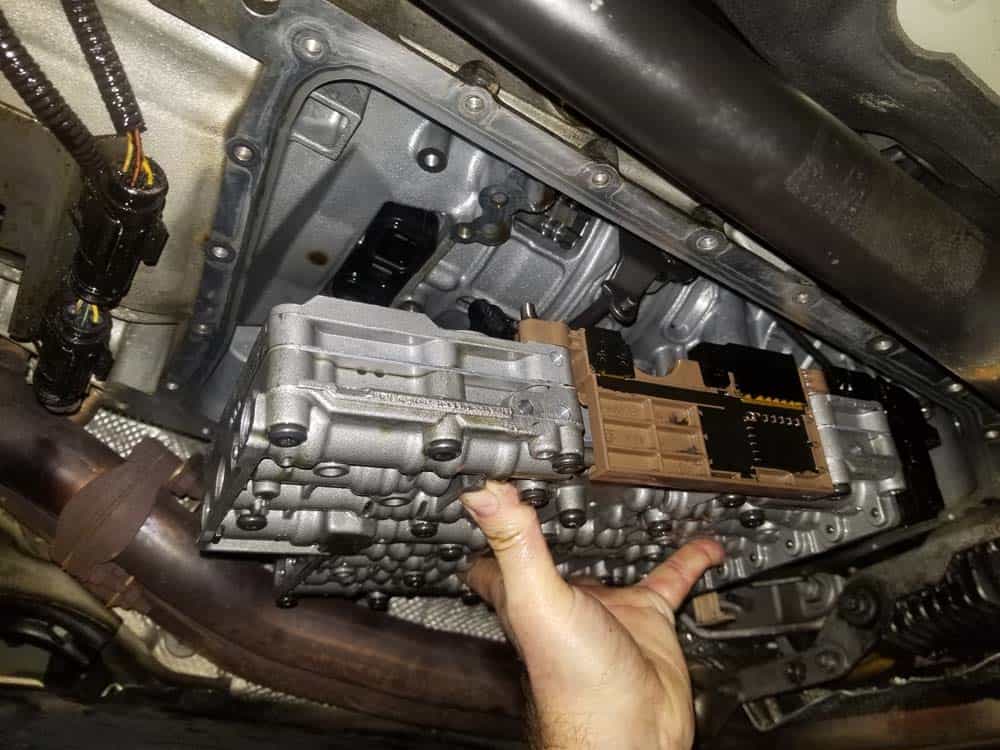
- Place the valve body on a clean bench.
Section 3 - Replacing the BMW Transmission Solenoid
Replacing the BMW transmission solenoids is a very straightforward procedure. It requires separating the electronics module from the top of the valve body then replacing the solenoids which are held in place with a simple metal plate. It is strongly recommended that you replace the valve body sealing sleeves and adapter while doing this step in order to properly fix your transmission. Please see our article BMW Mechatronics Sealing Sleeves and Adapter Repair.- Using a T27 torx bit, remove the six bolts anchoring the valve body to the black plastic electronics module as shown in the following diagram.
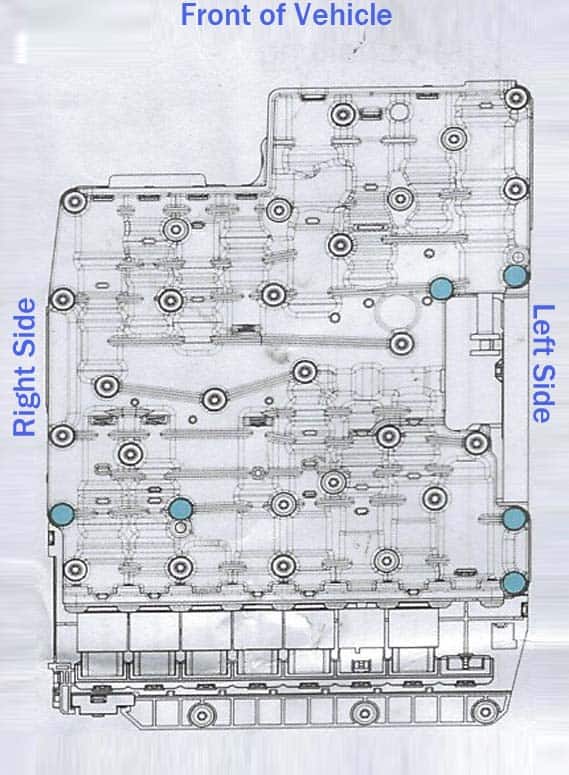
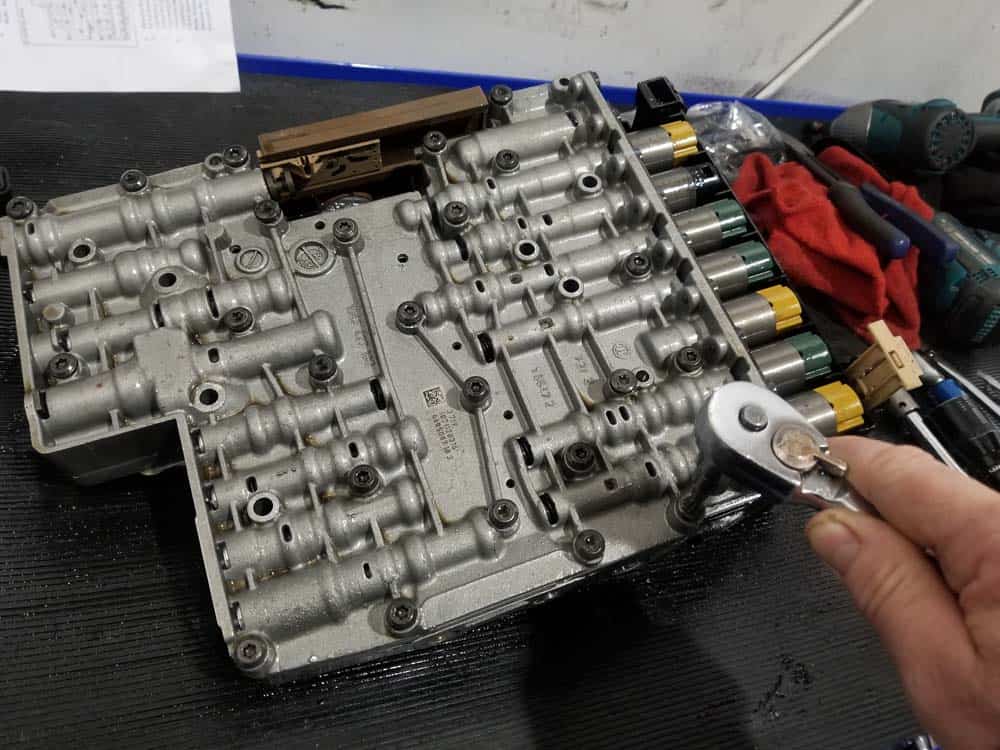
- Carefully flip the valve body over and begin removing the electronics module. The module is mounted very tight...DO NOT force it off. We like to start at the solenoids and move our way forward down the sides (see image below). Move slowly and methodically...never force the module off. If you are having trouble separating them, make sure you have removed all of the bolts (refer back to the diagram above).
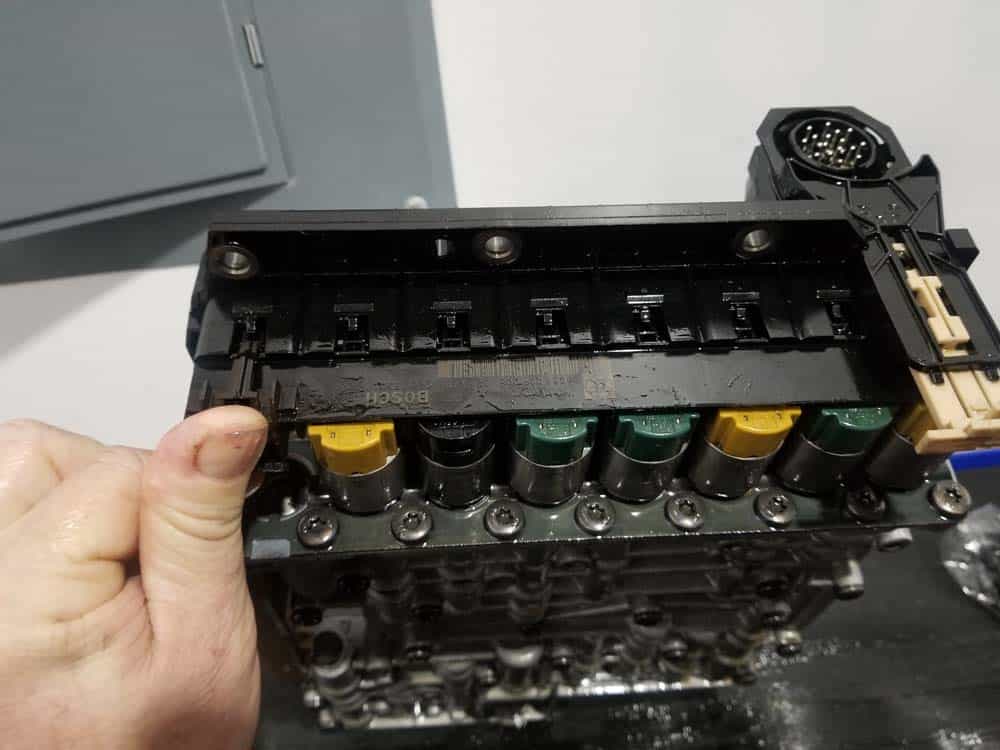
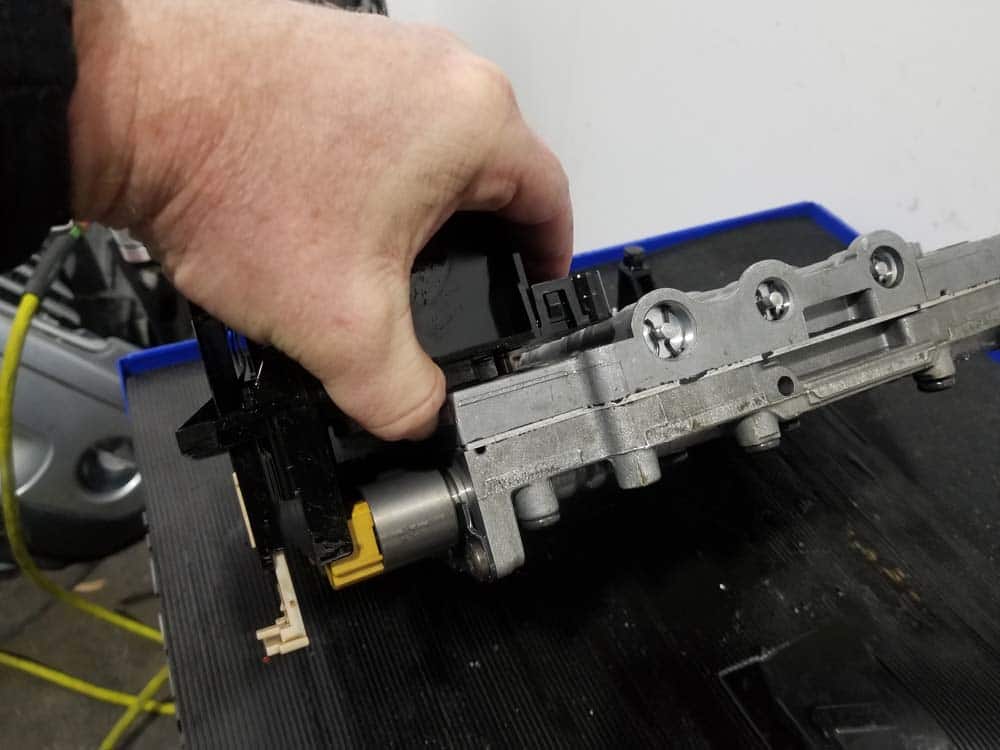
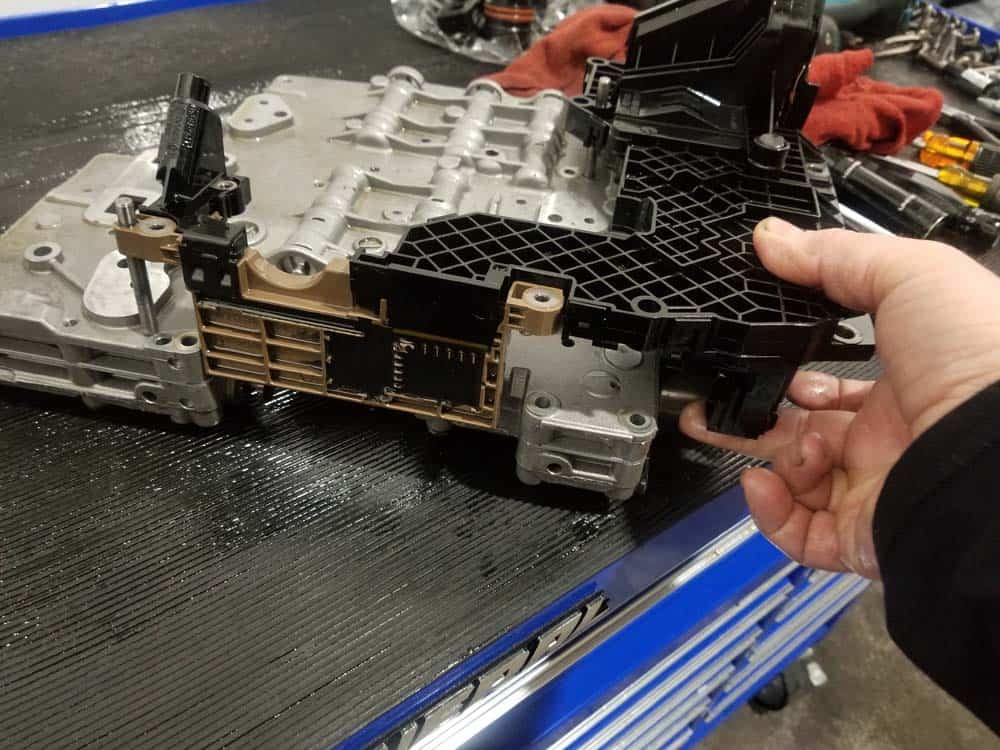
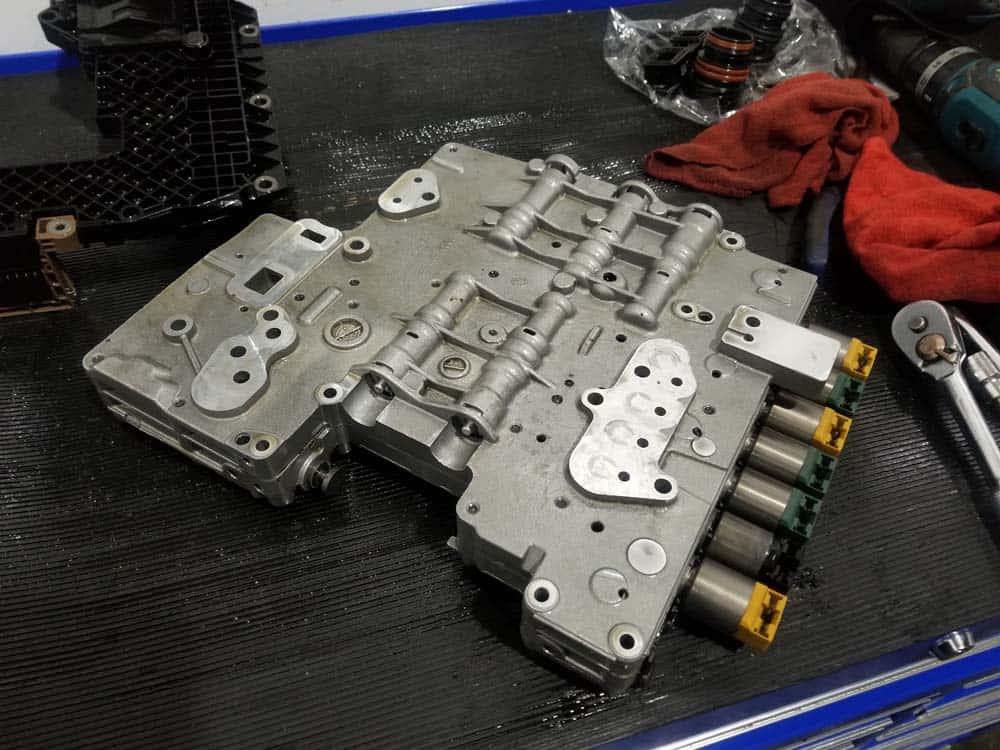
- Flip the valve body back over. Using a T27 torx bit, remove the nine bolts securing the solenoid retaining plate to the valve body.
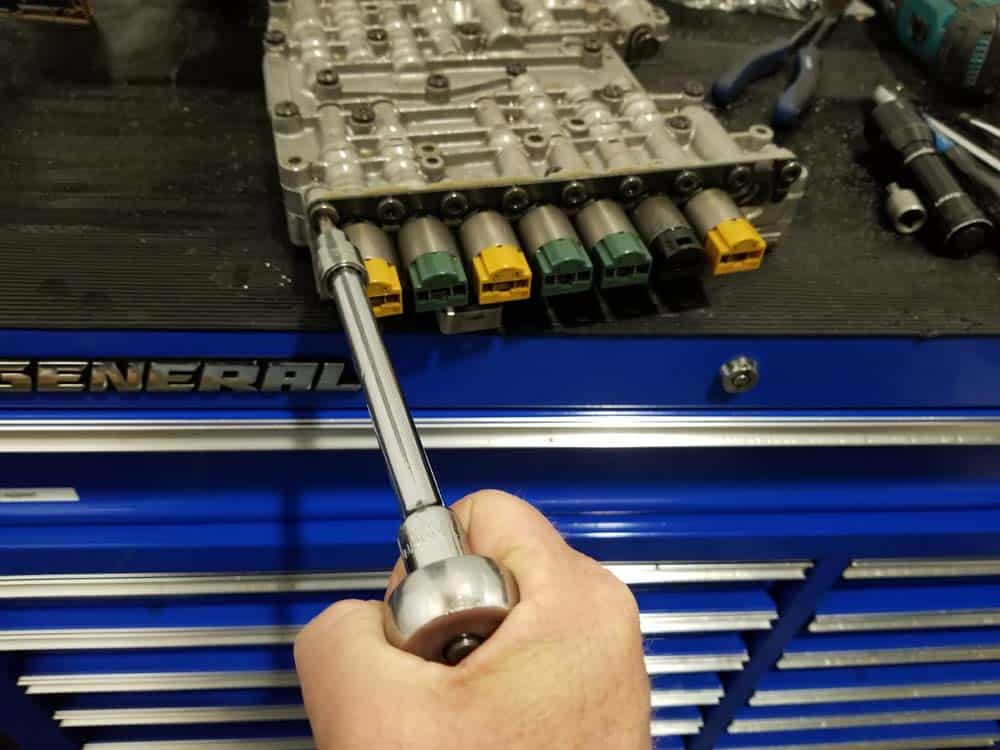
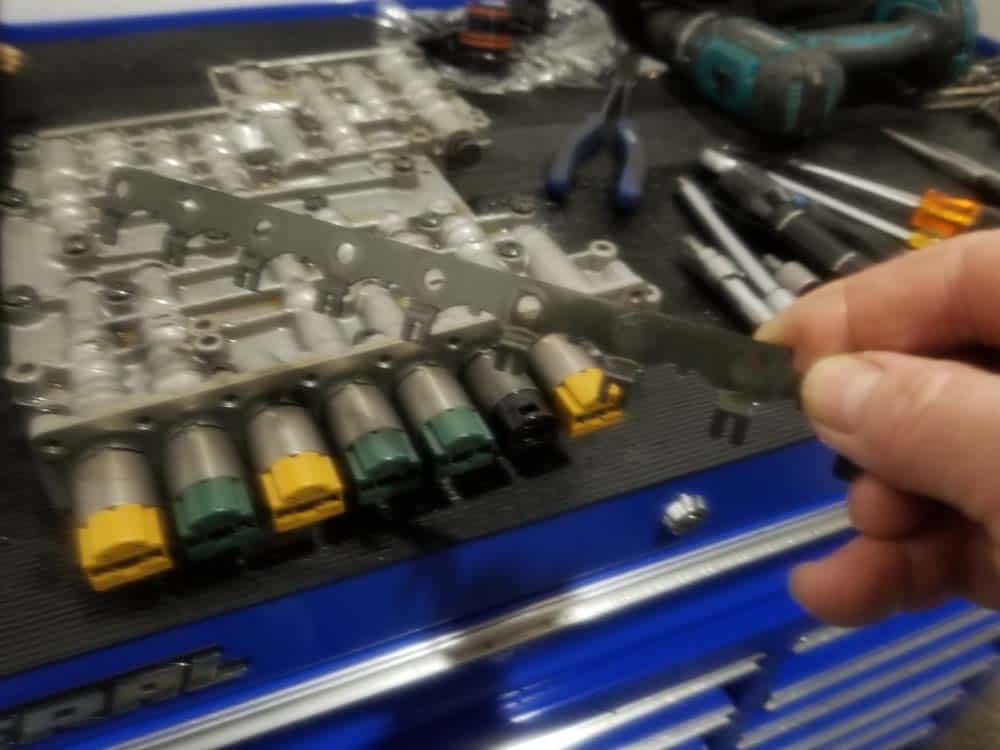
- Unpack the new BMW transmission solenoids and verify the colors match. Note - ZF has replaced green valve body solenoids with blue. They are interchangeable and function exactly the same.
- Remove the first solenoid from the valve body by grasping it firmly and pulling it out. It is held in place by two o-rings.
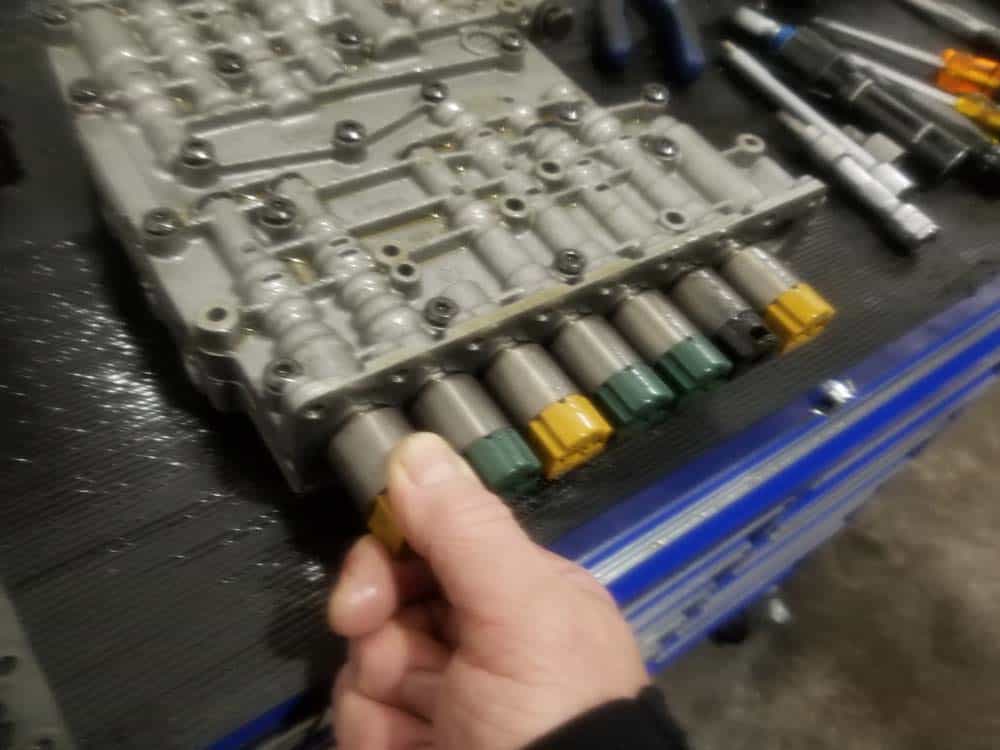
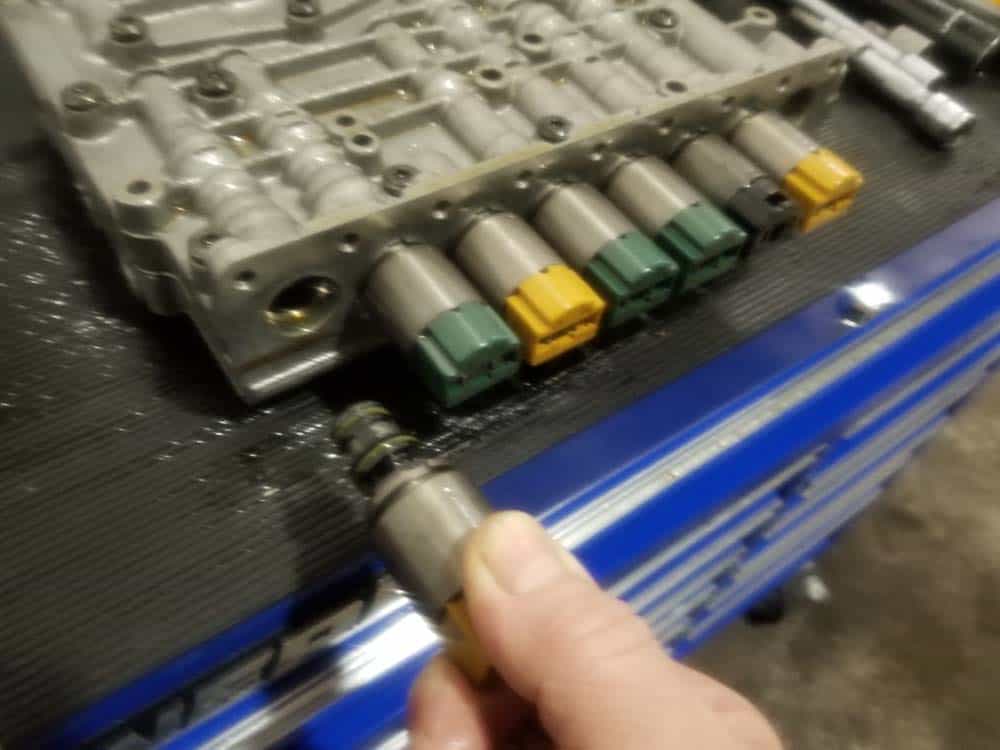
- Replace the solenoid with a new one of the same color, noting the correct orientation as shown in the following image. You may have to push firmly to get it in.
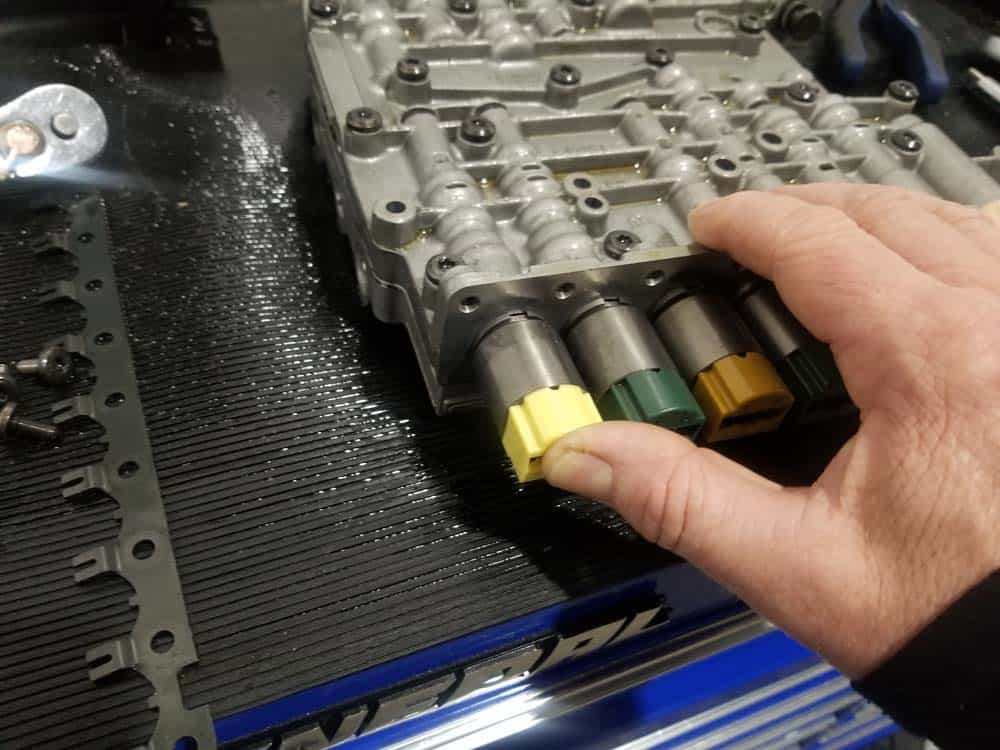
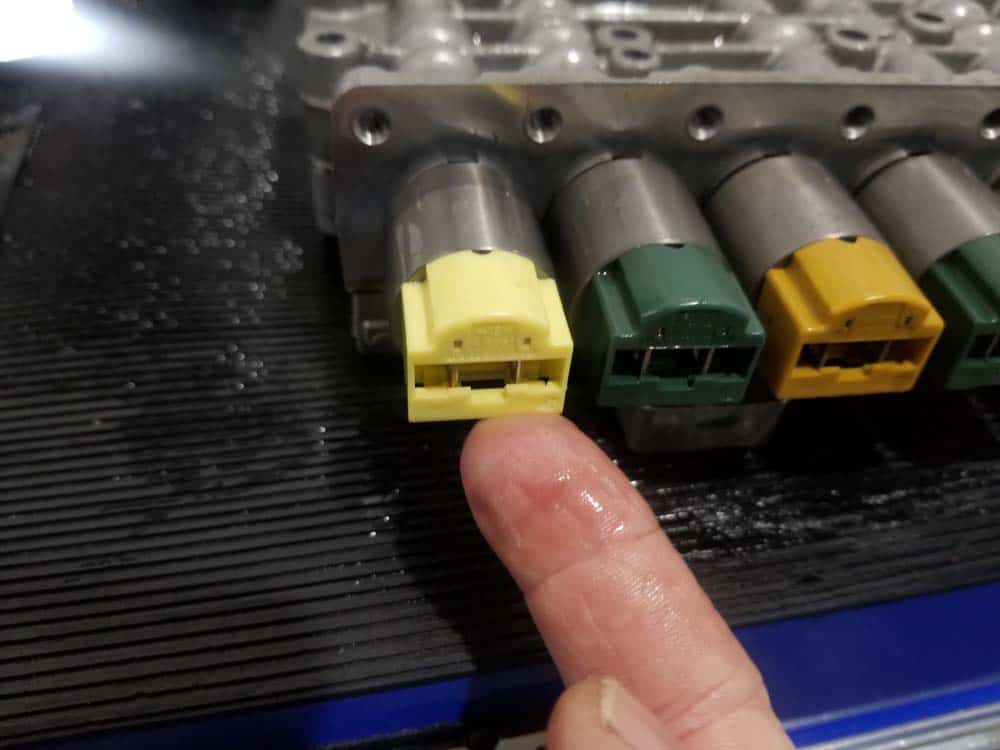
- Continue to replace the other six solenoids.
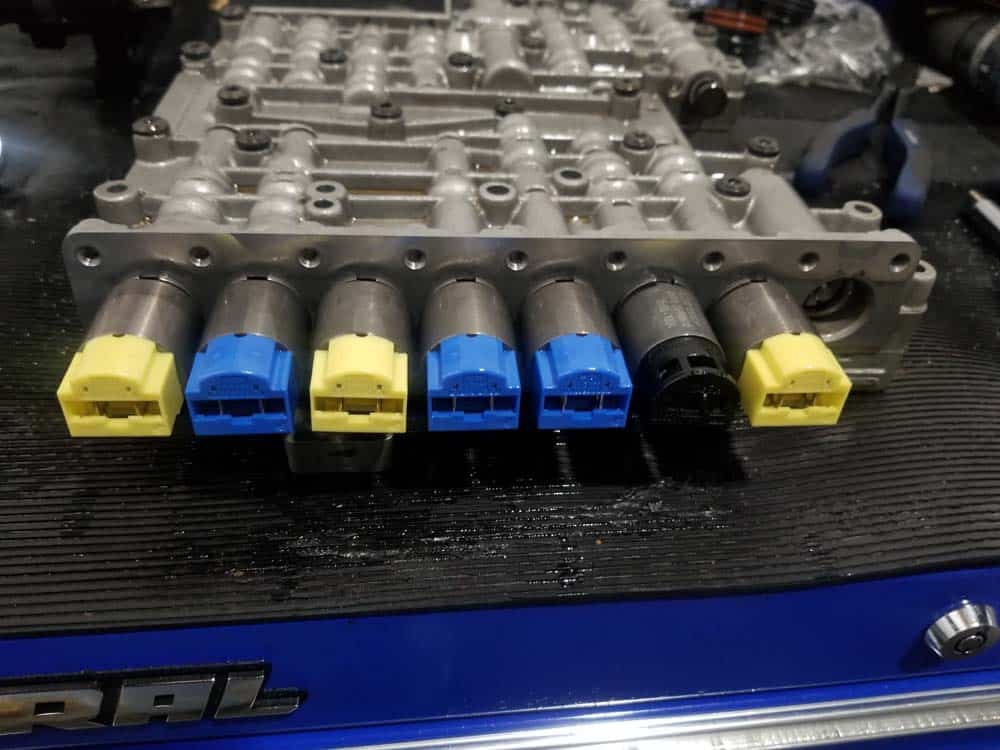
- Double check to make sure all of the new solenoids are aligned correctly. Replace the solenoid retaining plate and torque the bolts to 6 Nm (4 ft-lb).
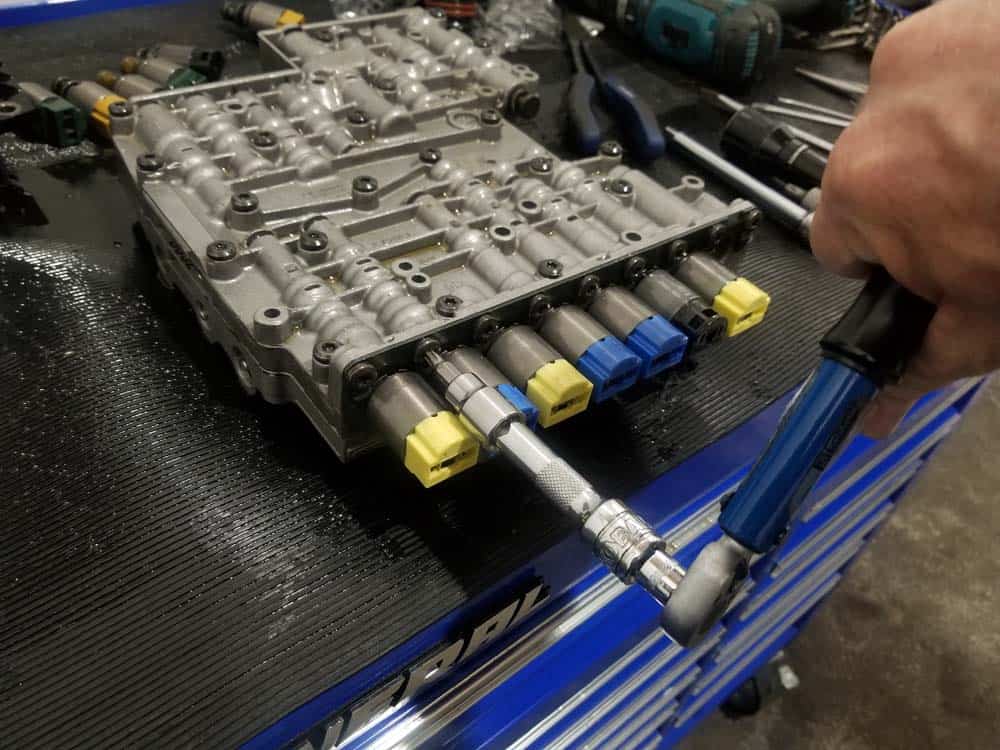
- Carefully reinstall the electronics module...never try and force it back on. Start with the front making your way back towards the solenoids. Make sure the piston rod in the front of the valve body lines up with the pin on the electronics module as shown below.
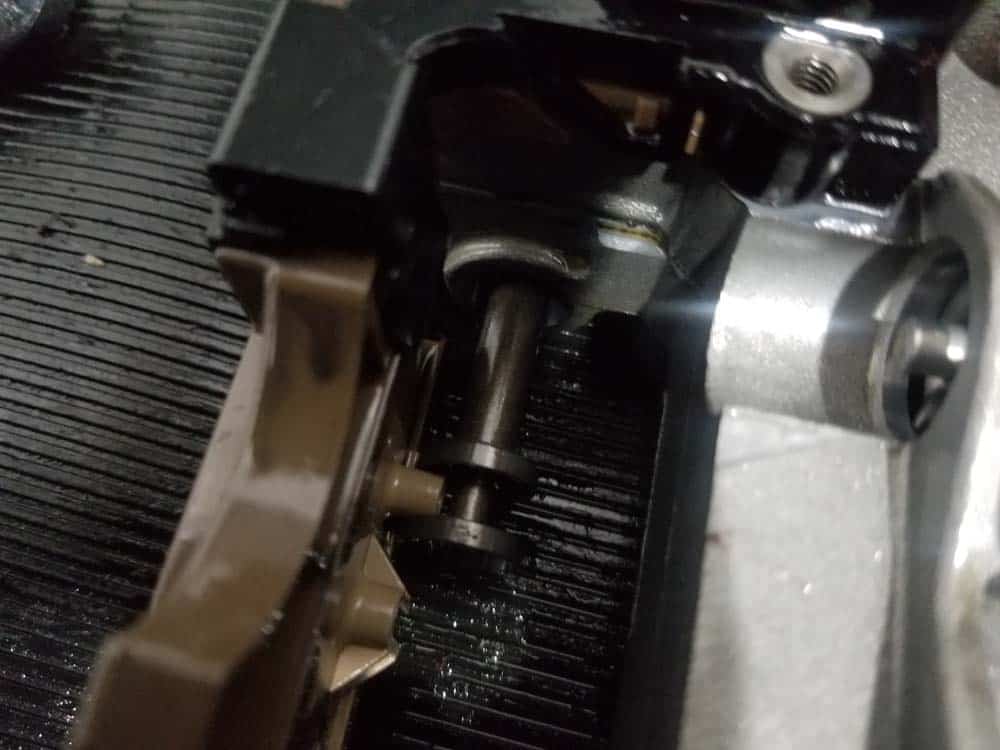
- Moving to the rear of the module, make sure the metal electrical connectors in the module line up with the solenoids (see image below).
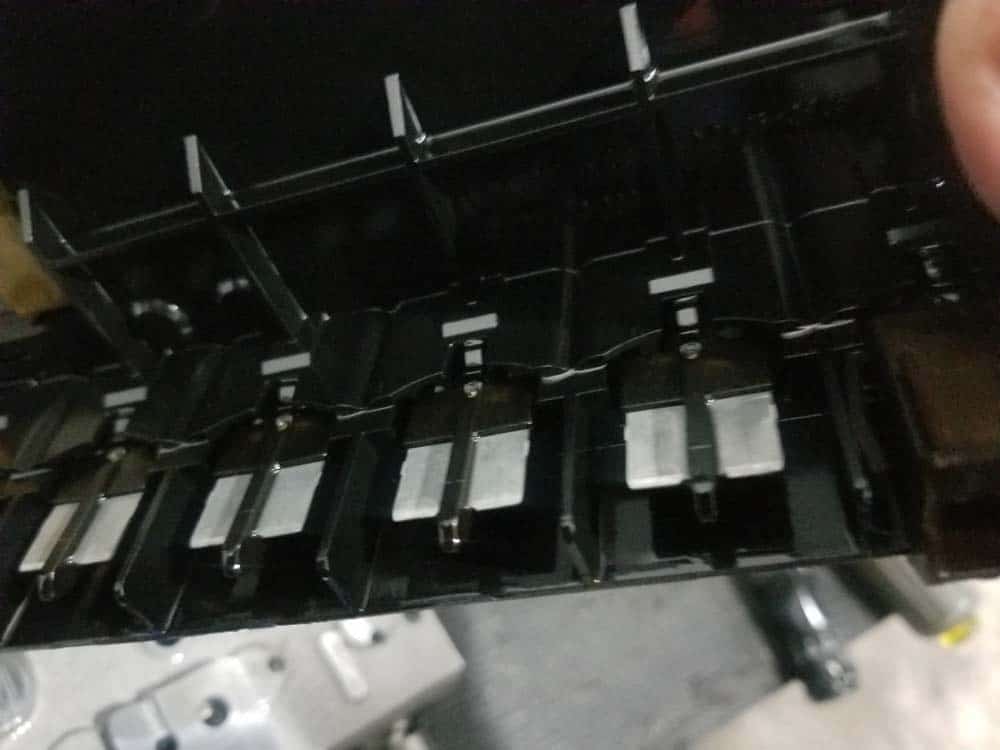
- Reinstall the nine T27 bolts anchoring the electronics module and torque to 6 Nm (4 ft-lb).
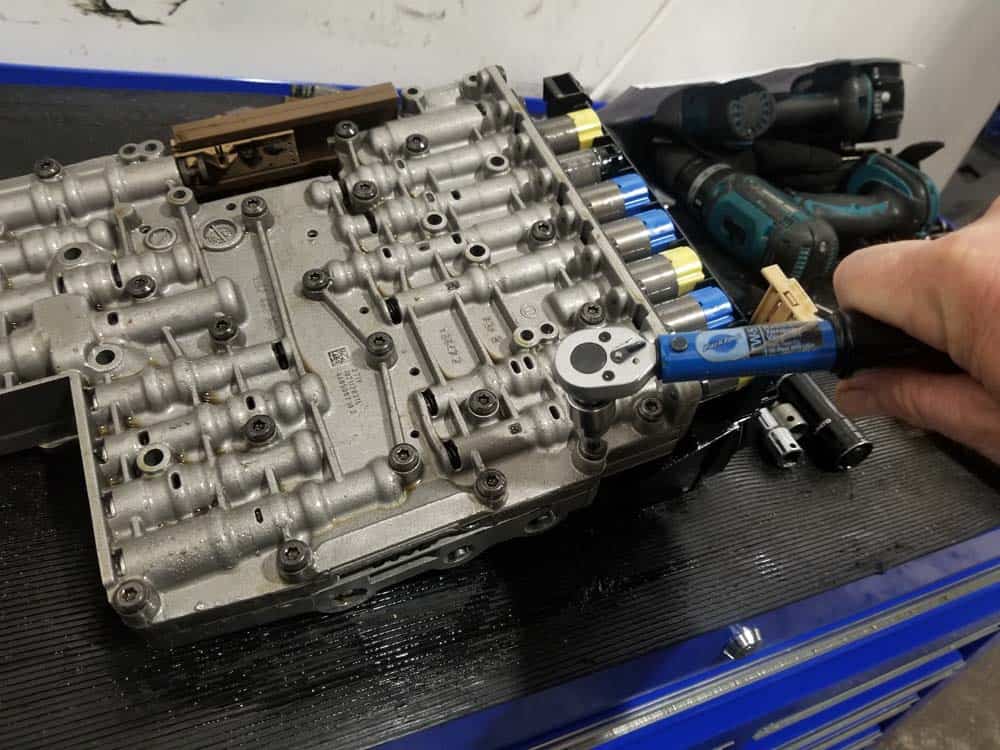
- Use some CRC Brakleen and a clean rag to thoroughly wipe down the valve body where the mechatronics sealing sleeves and adapter attach. Make sure to remove any old residue that may keep them from creating tight seal.
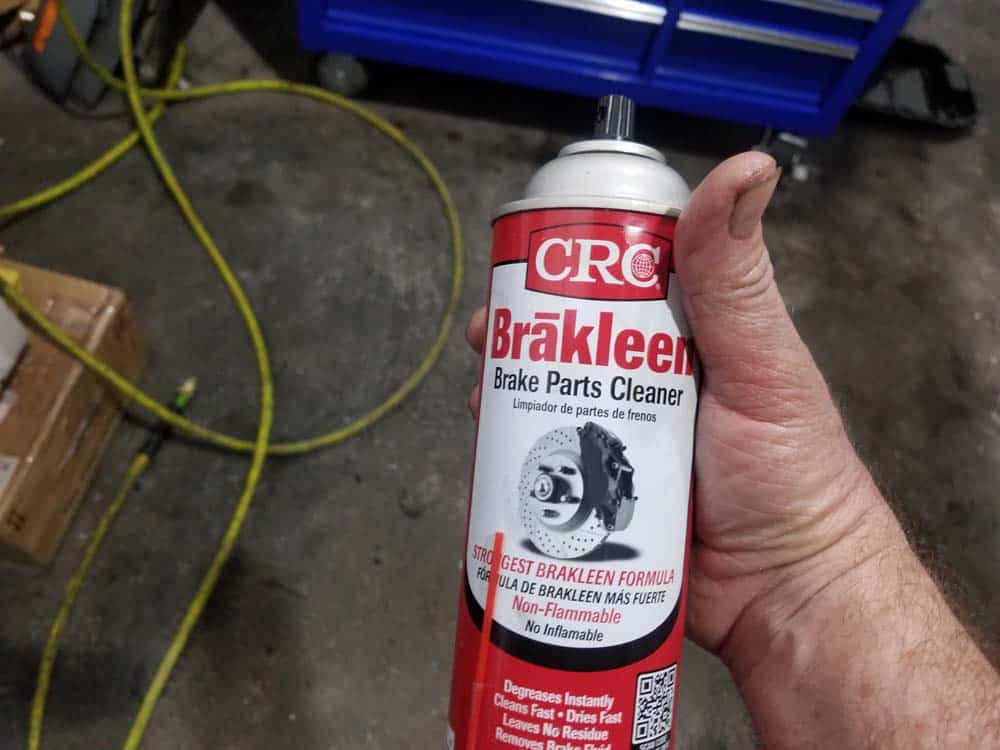
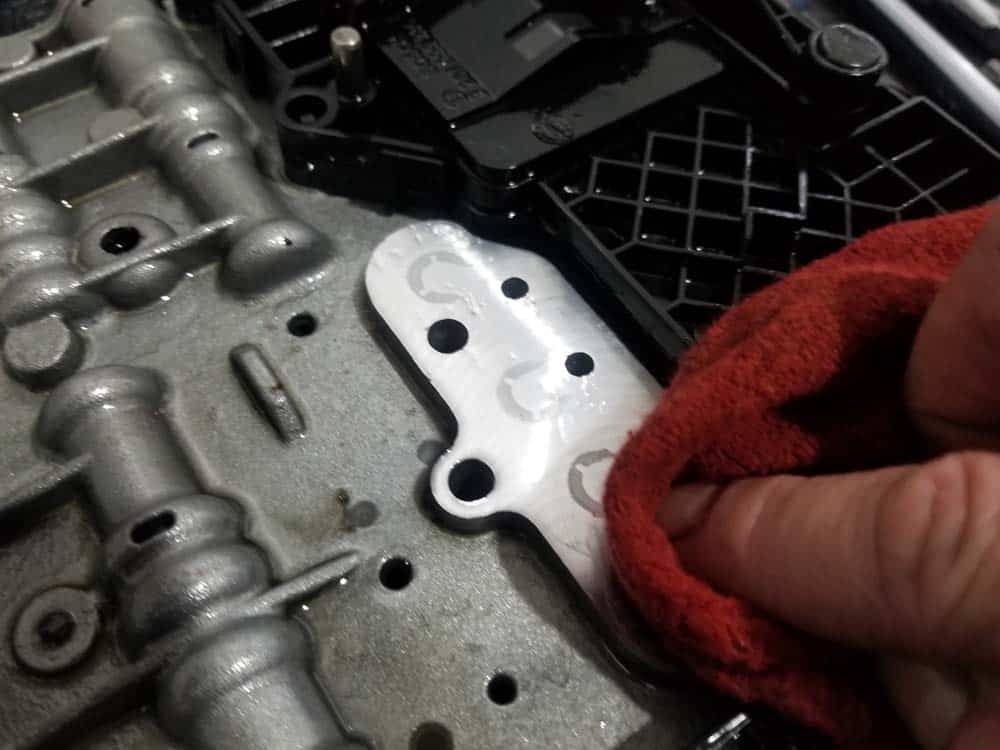
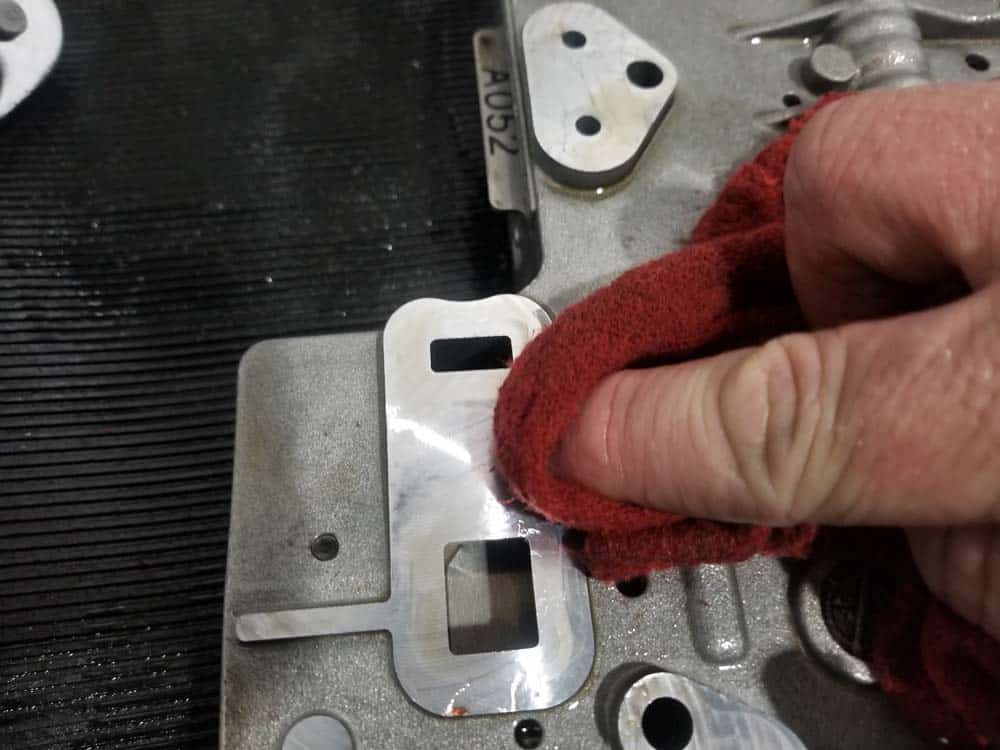
- Spray the valve body’s electrical connector with some CRC electronics cleaner.
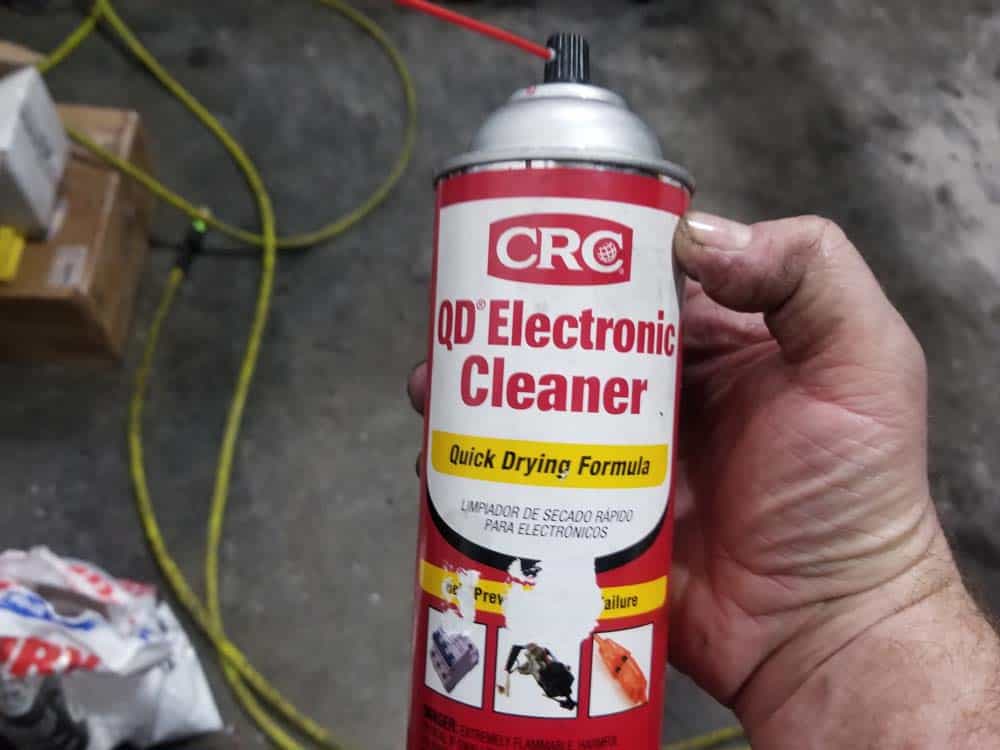
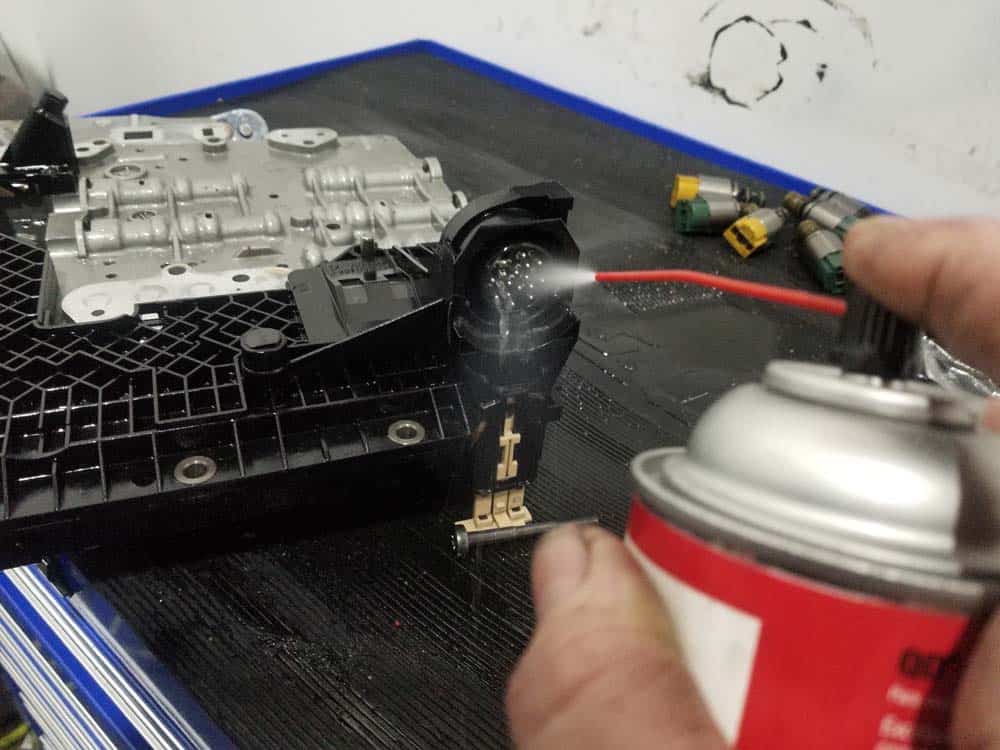
- Lift the valve body up and align it on the transmission. ***VERY IMPORTANT - Make sure the pin on the shift bracket lines up properly with the piston rod in the valve body. It is a very common mistake to put the valve body back on without lining them up. (see image below).
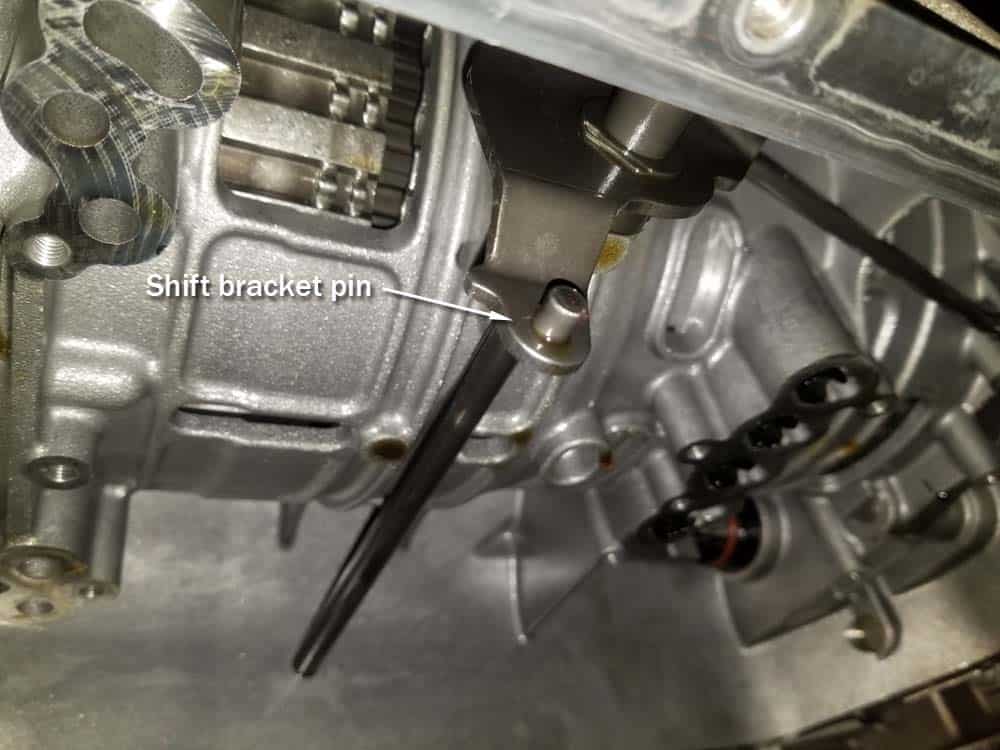
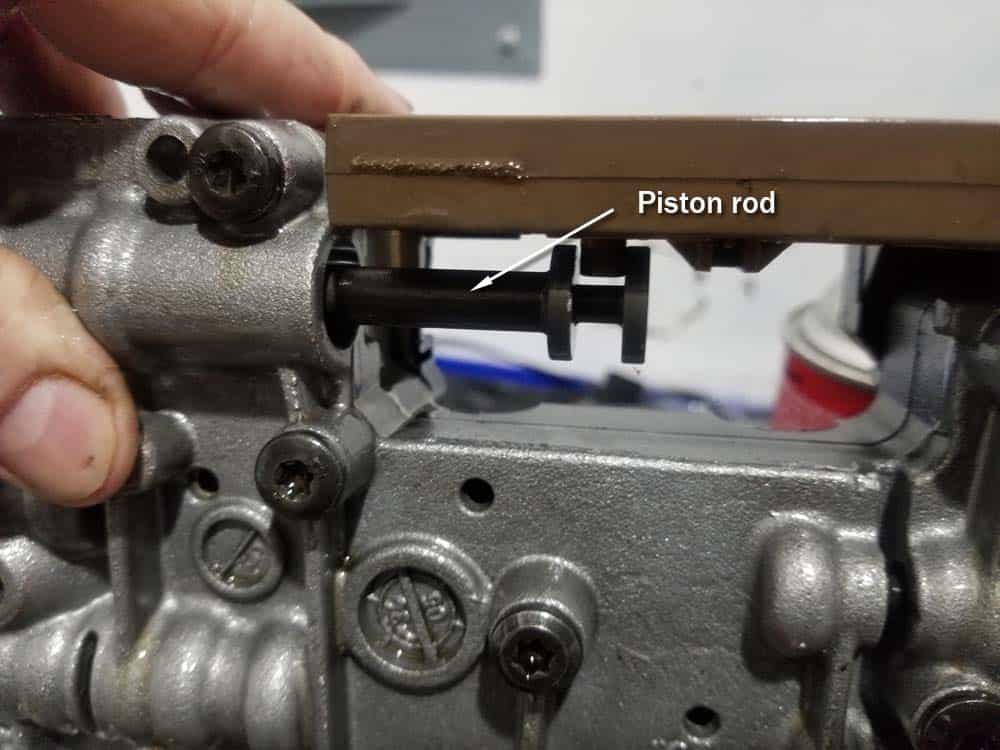
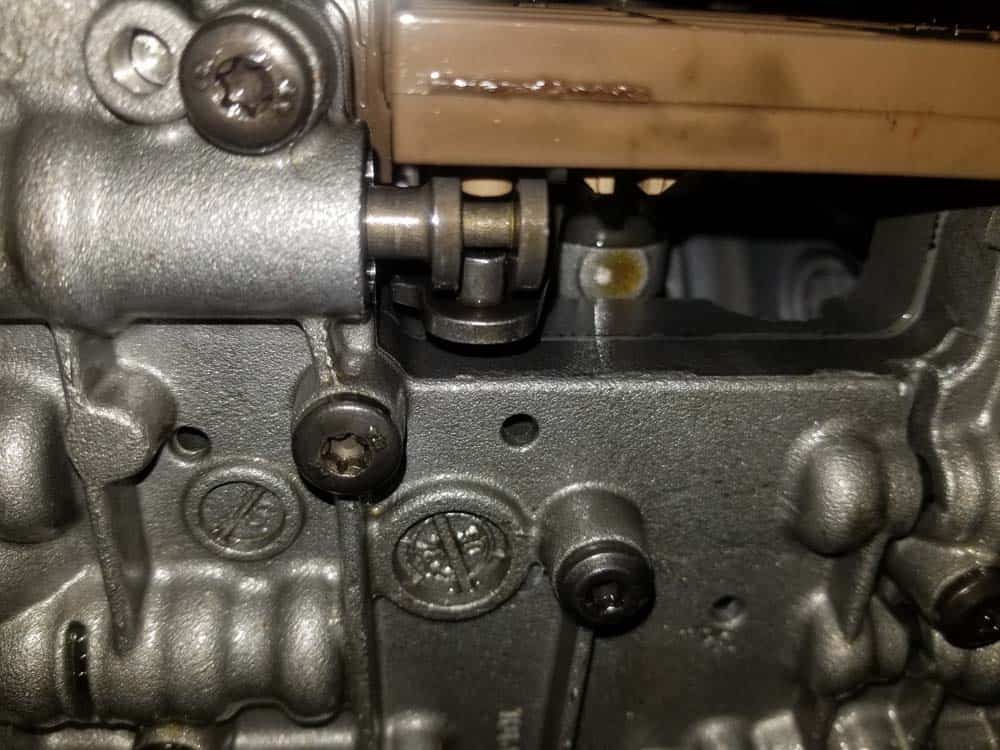
- Install the ten T40 mounting bolts and torque to 8 Nm (6 ft-lb).
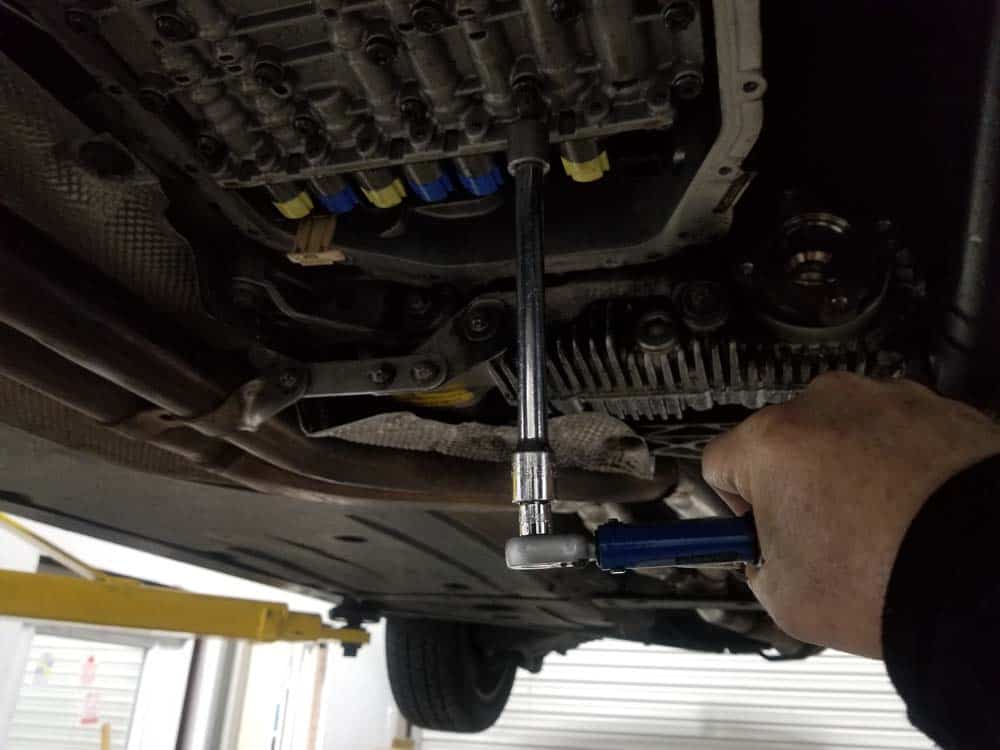
- The electrical connection sealing sleeve has a tab in it that must line up with a notch in the electronics module for it to properly install. You will not be able to close the locking mechanism until the sealing sleeve is properly installed into the valve body.
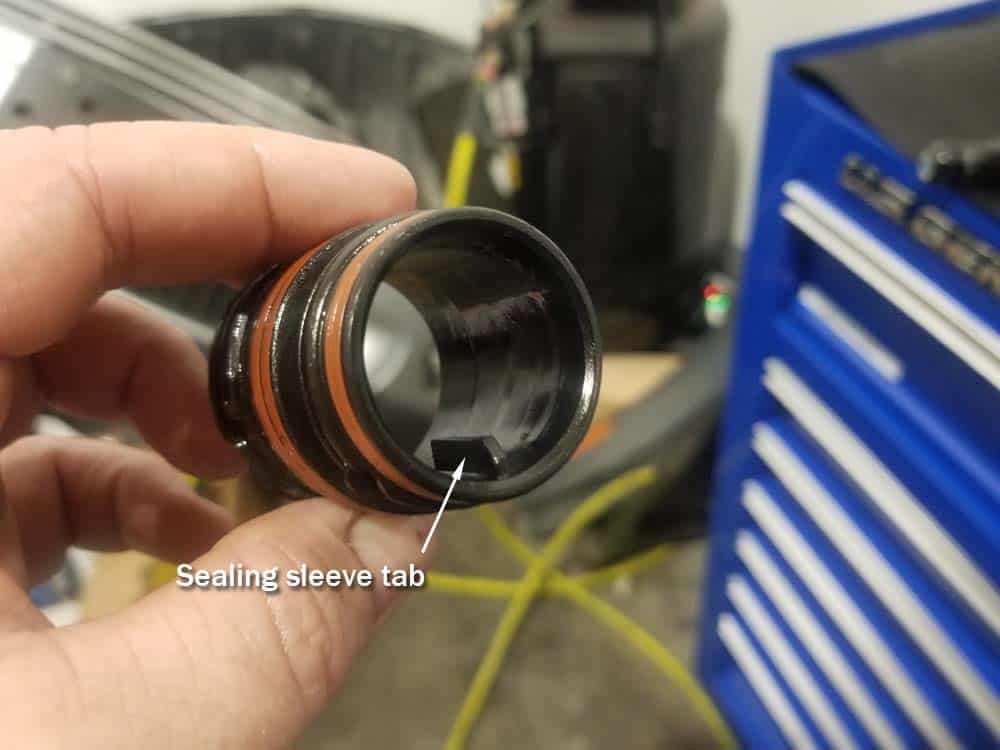
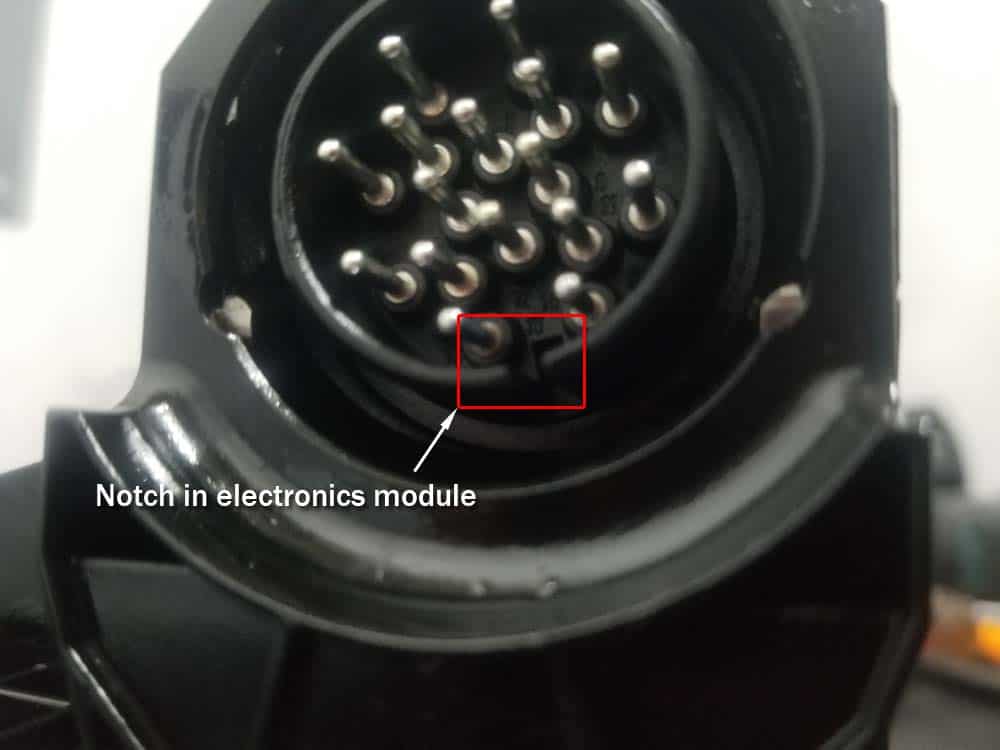
- Reach up and behind the transmission and install the new electrical connection sleeve. Turn it slowly until the tab on the sleeve lines up with the notch in the electronics module. Push the sleeve in as far as it will go and close the locking mechanism. If the locking mechanism will not close, then the sleeve is not seated properly in the valve body. Try reaching up and tilting it up and down until the locking mechanism closes.
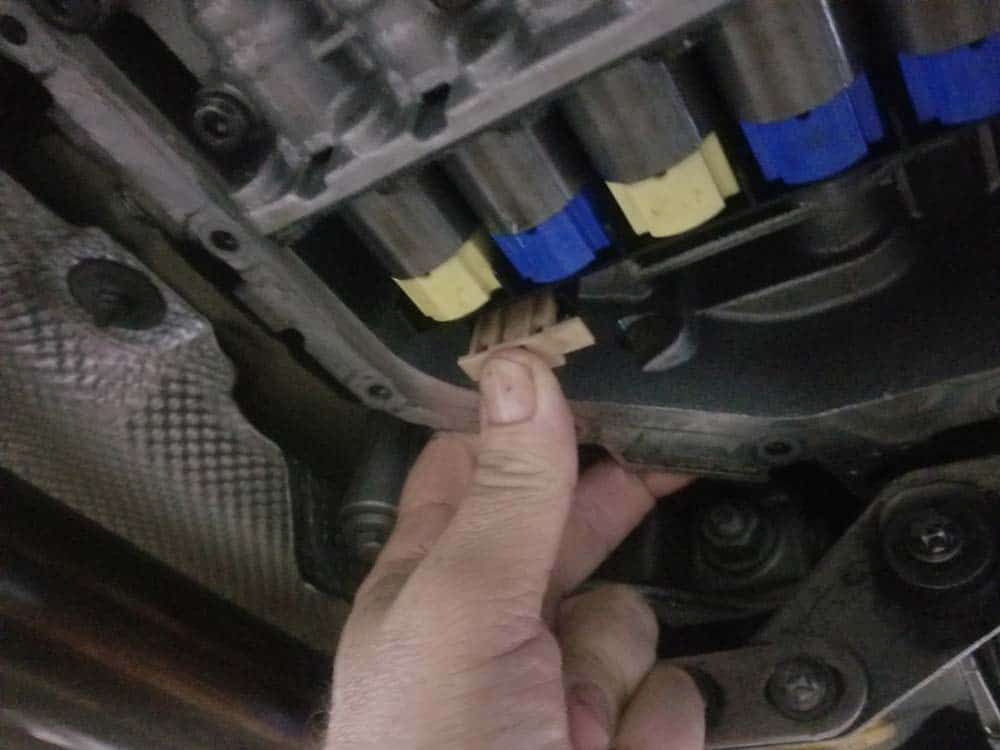
- Install the electrical plug back onto the sleeve. Turn the locking ring clockwise until it is snug.
- Install a new rubber gasket in the transmission oil pan.
- Using a rag and some CRC Brakleen, thoroughly clean the transmission surface that the oil pan attaches to. Make sure to remove any dirt, grime and oil…all of these can affect the gasket’s seal and cause leaks.
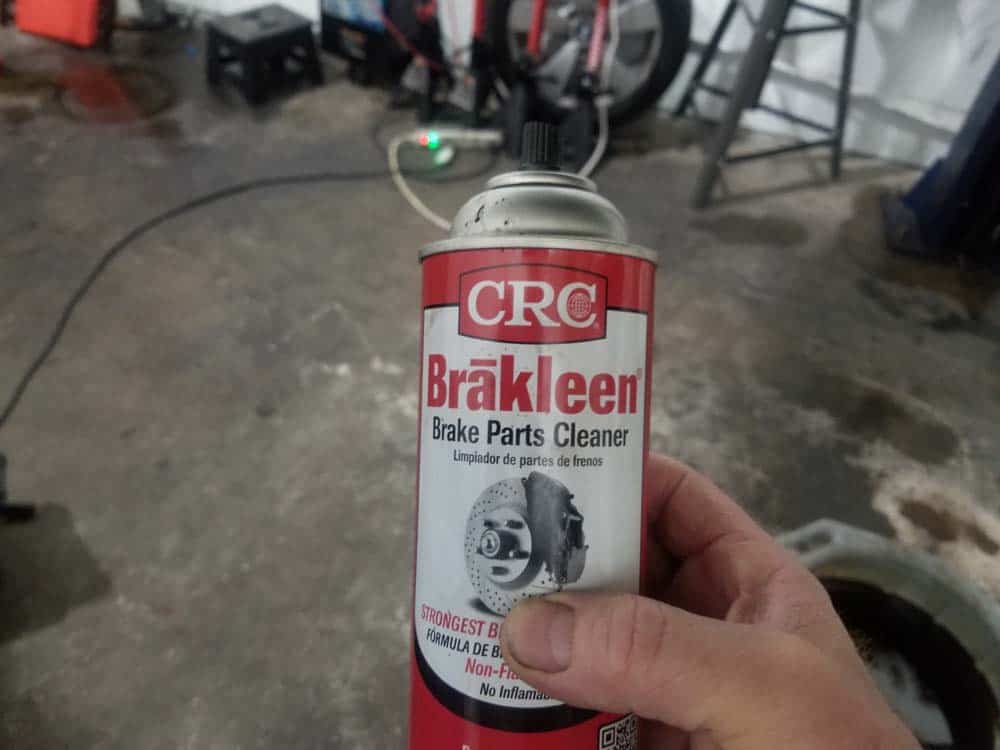
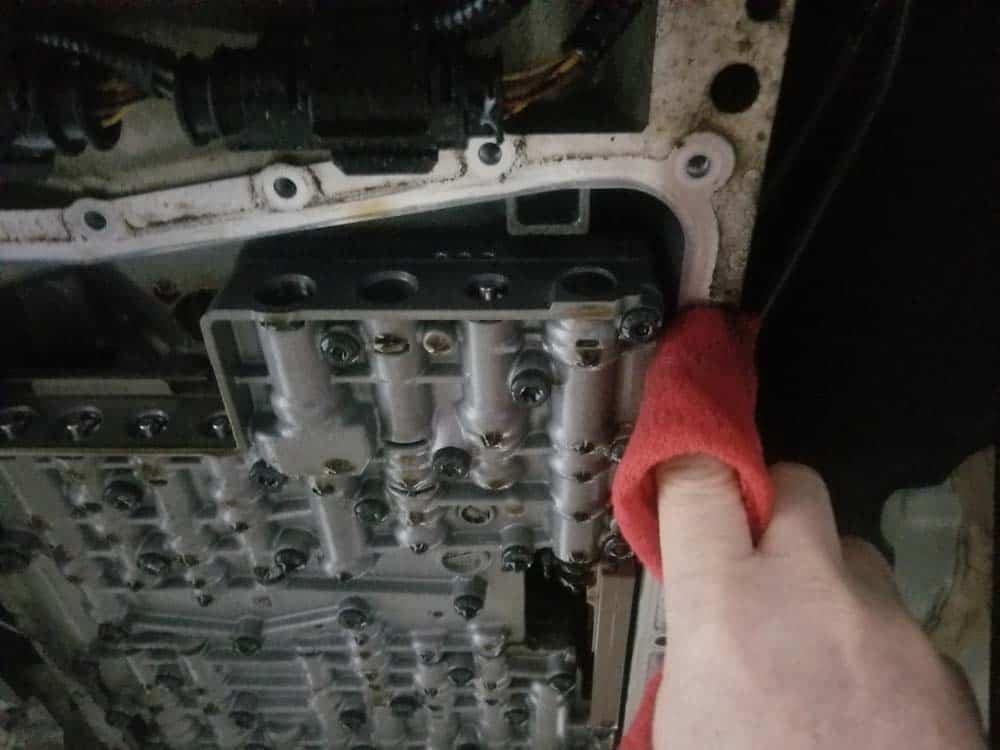
- Lift the oil pan back into position. Make sure the oil filter fits snugly into its opening in the bottom of the transmission.
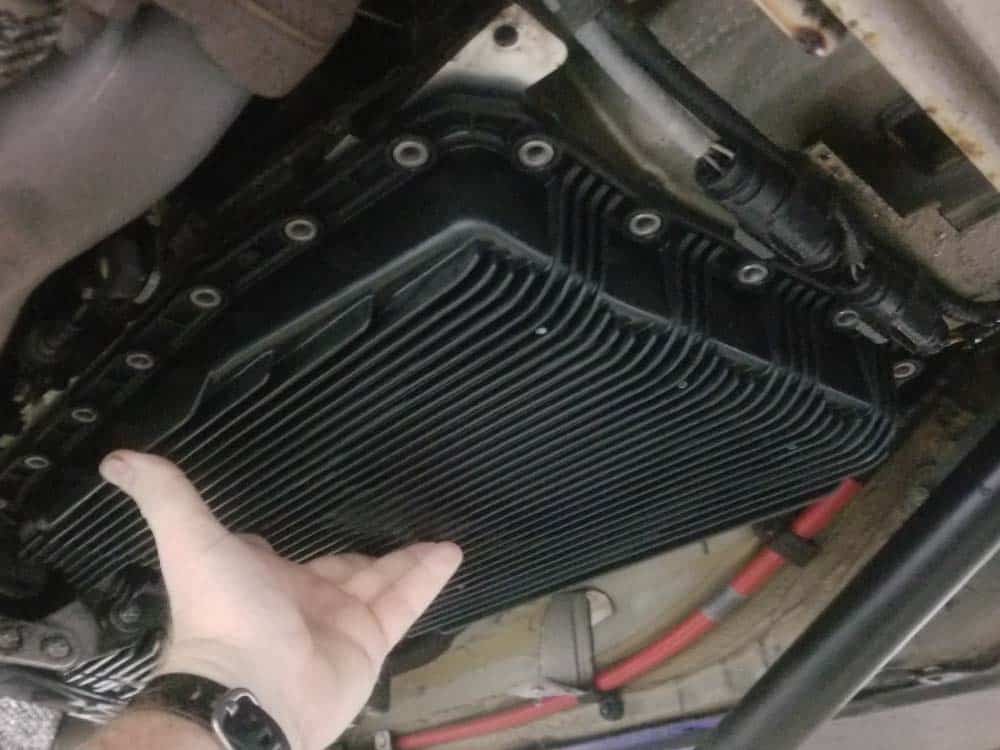
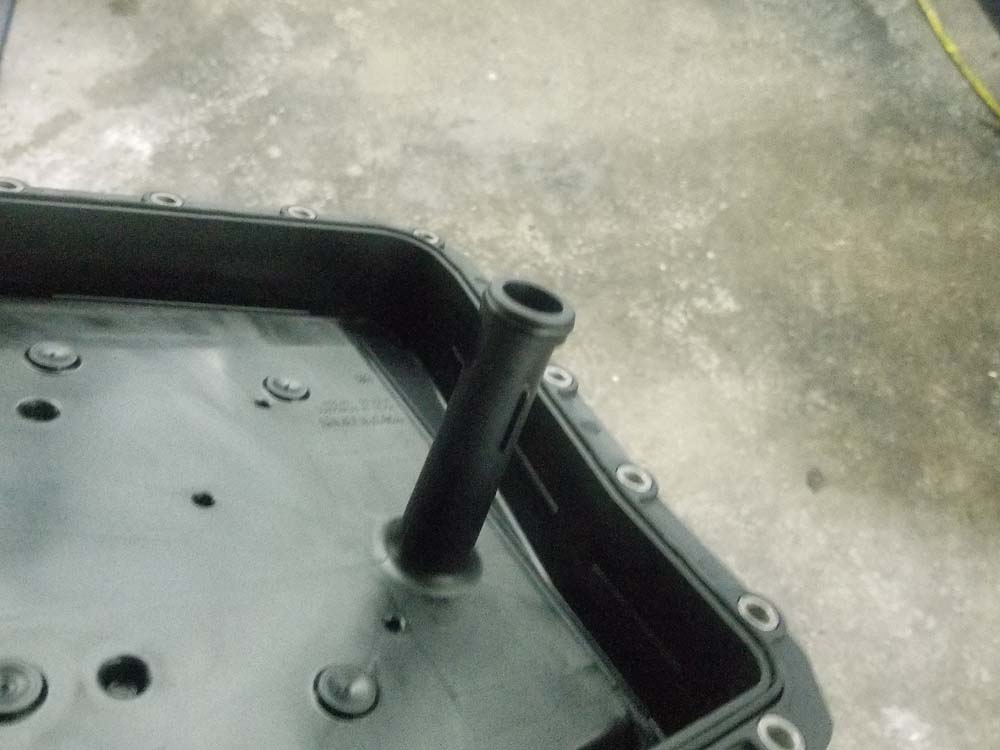
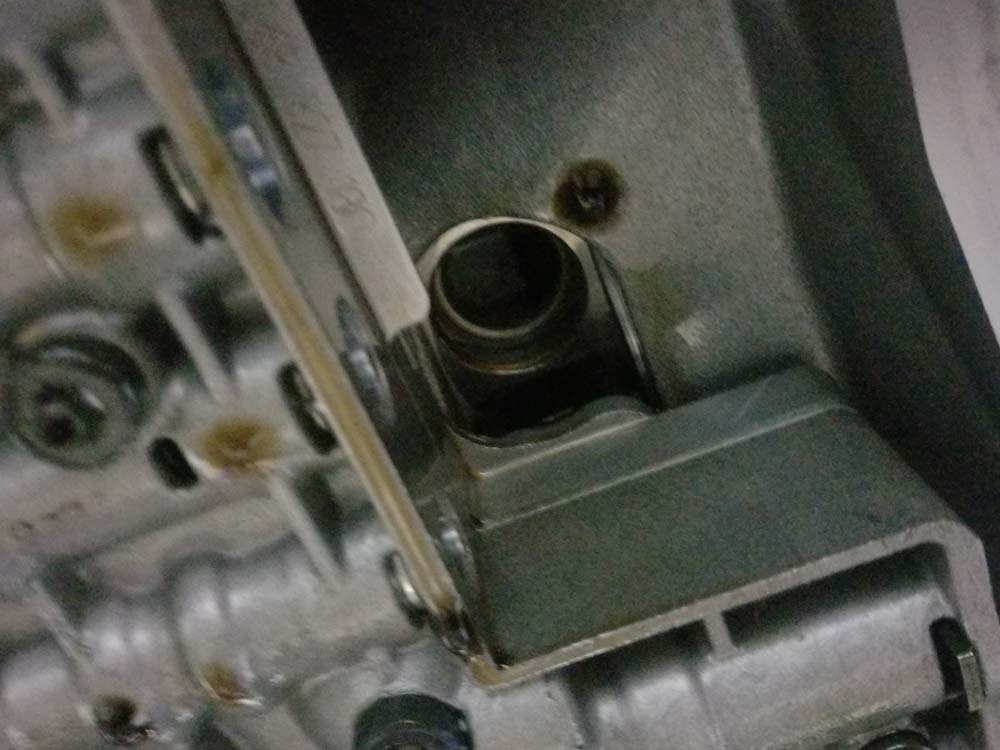
- Using the T40 torx bit, hand tighten the mounting bolts back into the pan.
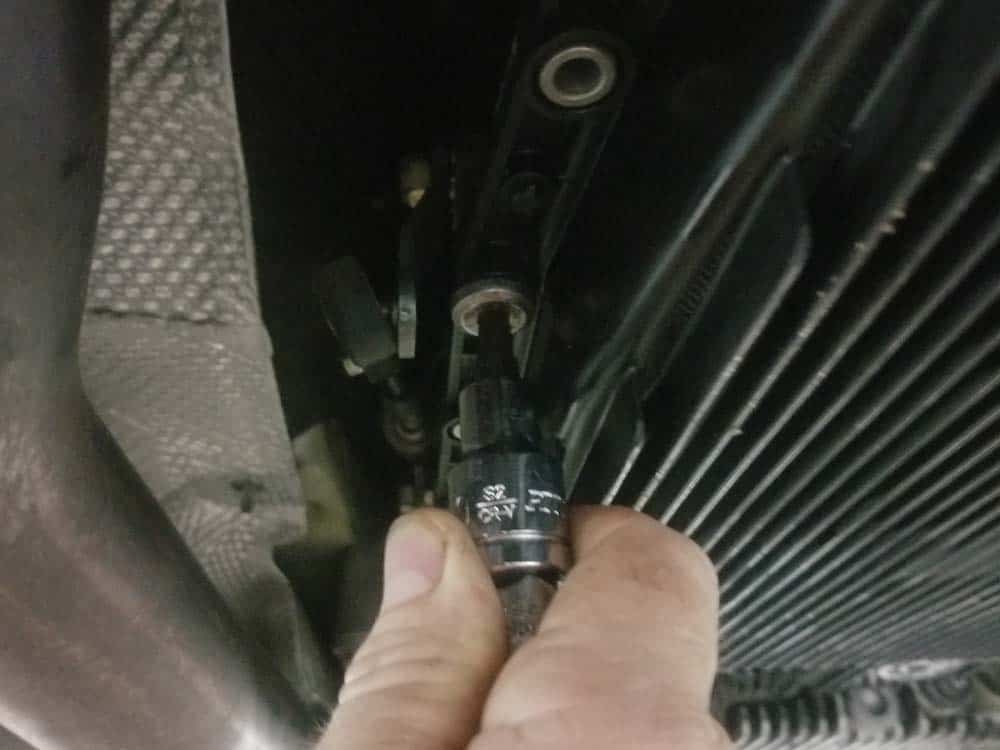
- Torque the transmission oil pan mounting bolts to 10 Nm (7 ft-lb).
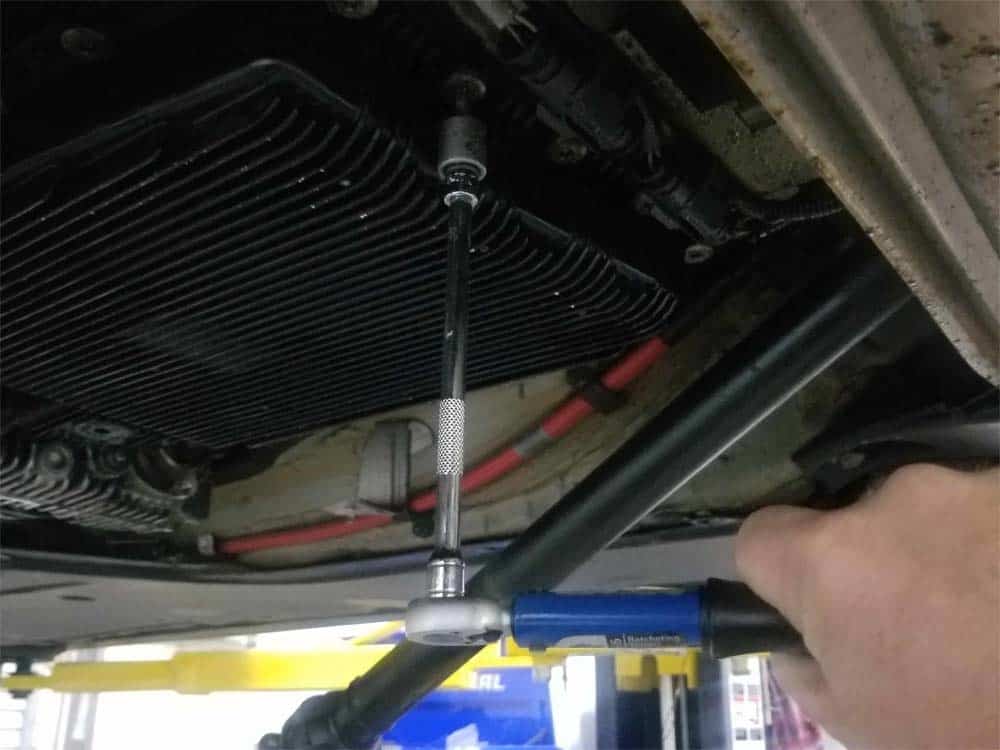
- Remove the transmission fill plug.
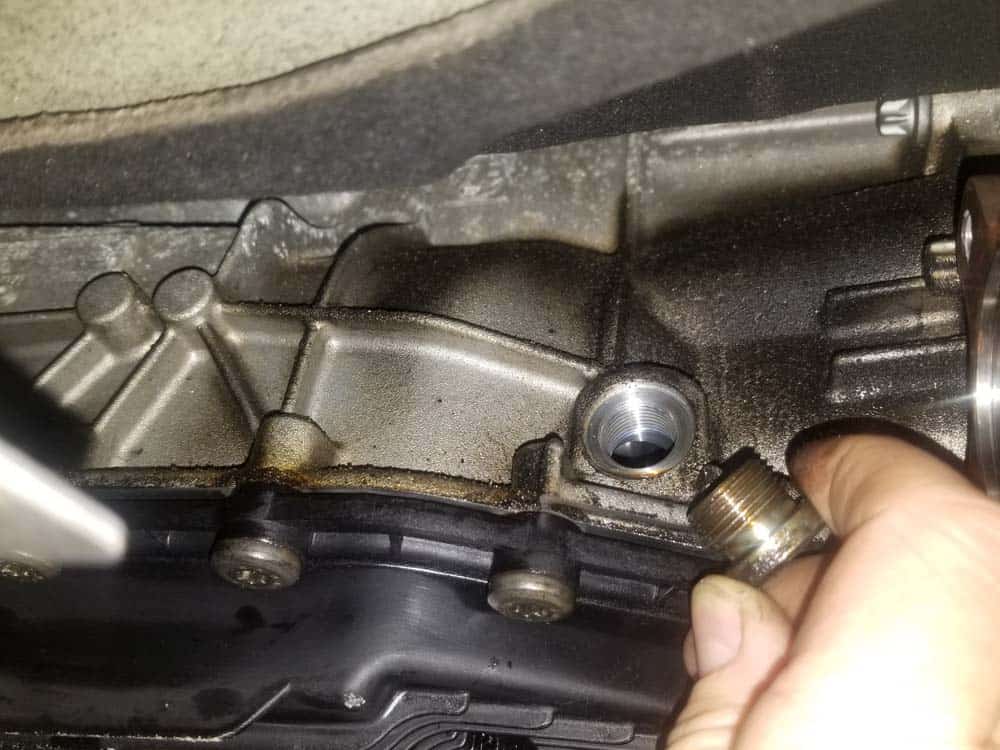
- Using a fluid transfer pump, fill the oil pan with approved fluid until it starts to run out of the fill hole.
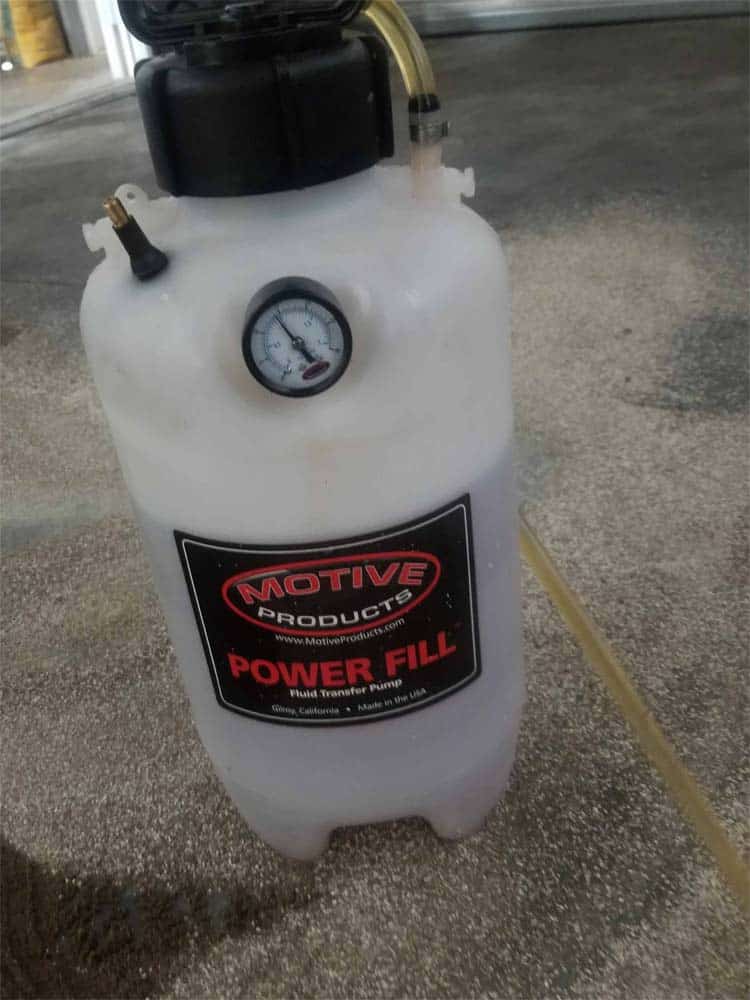

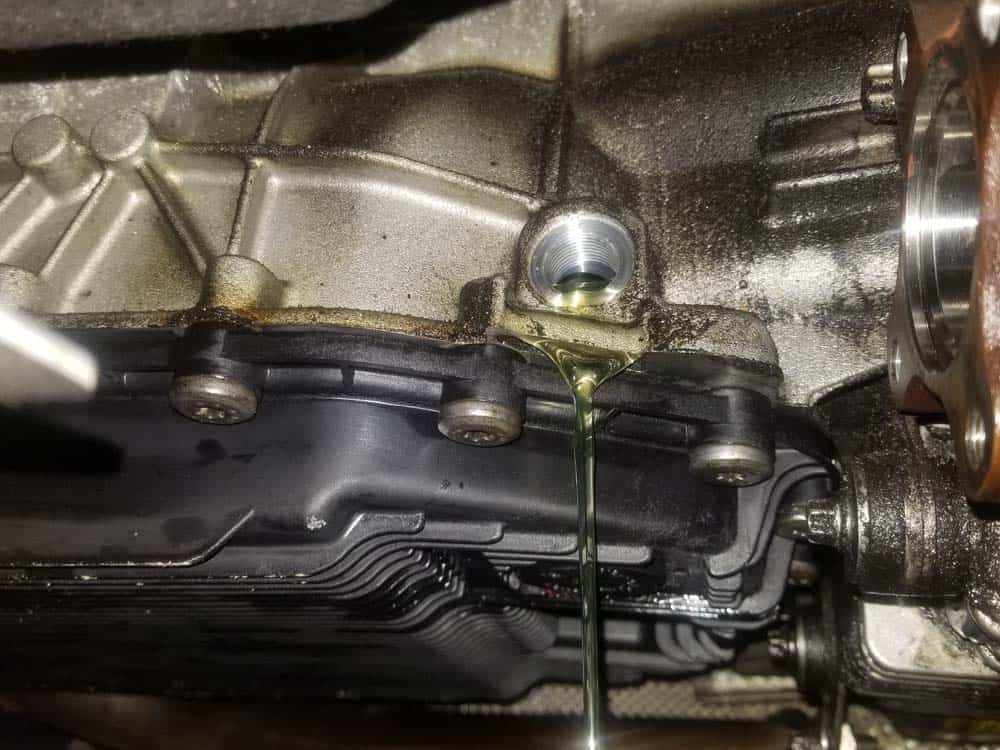
- Replace the plug and snug up with a T50 torx socket. DO NOT torque the plug yet...it will be removed again to check the final level of the transmission fluid.
- Next, the automatic transmission fluid (ATF) level needs to be checked. In order to get a correct ATF level reading, the fluid must be at a temperature between 86-122 degrees Farenheit (we recommend 100F). The correct way to determine the temperature of the ATF is to use a diagnostic scanner. If you are a home mechanic and do not currently own a scan tool for your BMW, we encourage you to purchase one as soon as possible. A scanner is as important to your tool chest as a set of socket wrenches. You can purchase a very affordable BMW diagnostic scanner by clicking here.
- First, connect your diagnostic scanner to the OBD-II port located in the driver's side footwell. Do not start the vehicle yet.
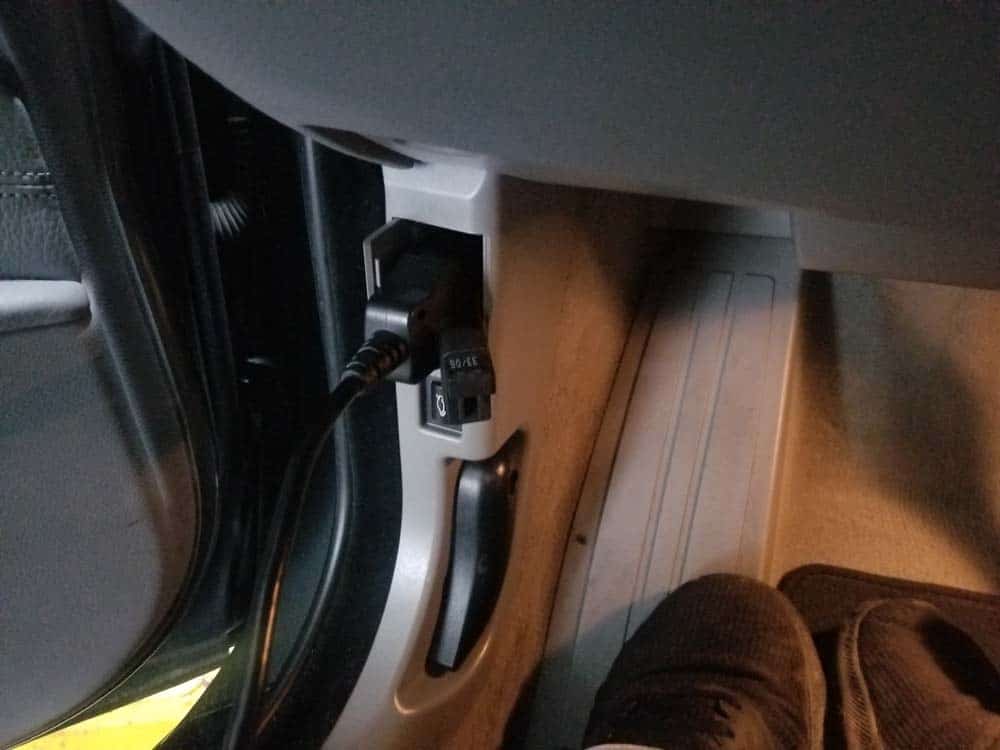
- With the vehicle off, scroll through the diagnostic scanner menu until you find the screen that monitors the transmission fluid temperature in live data. You want to keep the vehicle off because it may take you some time to find the correct screen. You don't want to start warming up the fluid until you are all ready to go. The following image shows the correct screen on the Schwaben (Foxwell) diagnostic scanner. This screen will differ among scanner manufacturers.
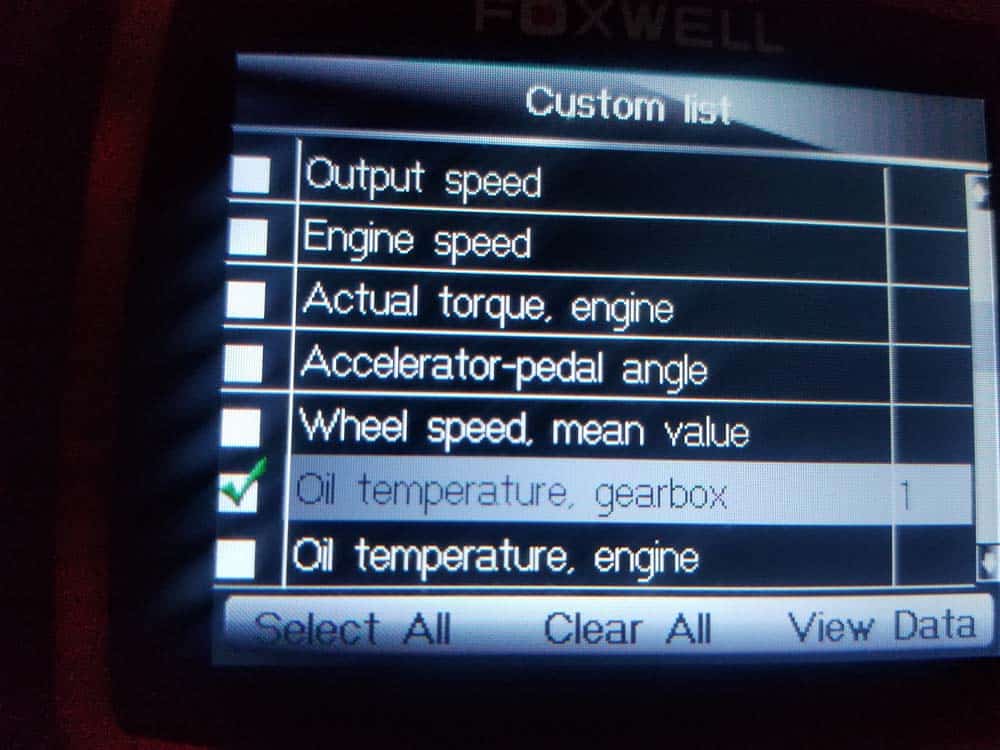
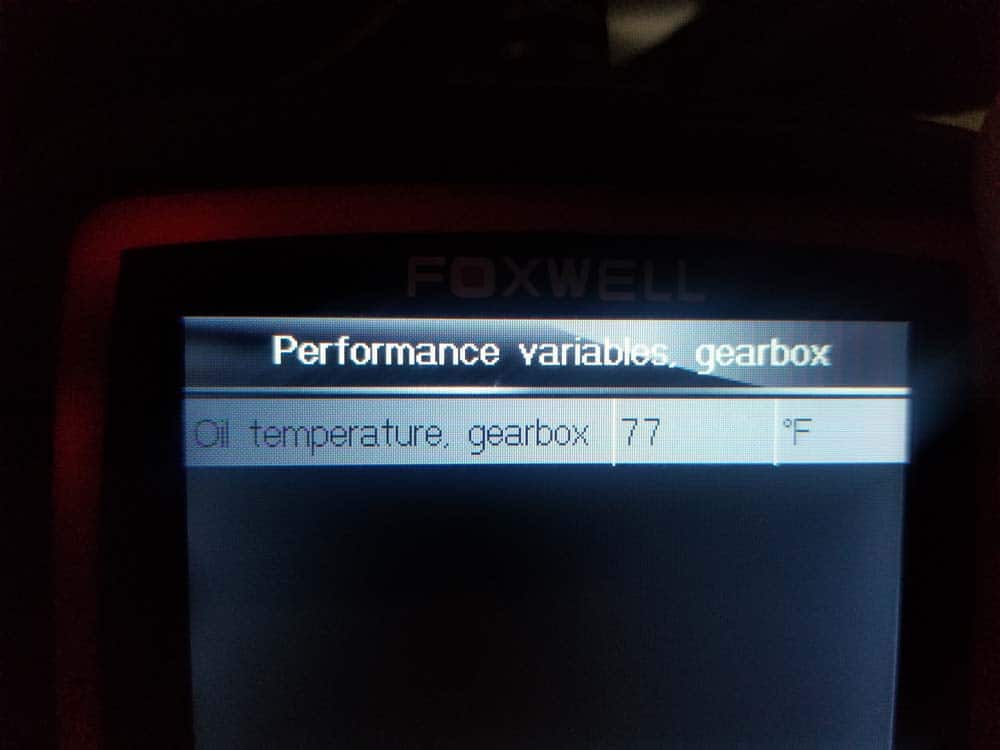
- Start the vehicle. Depress the brake pedal and hold. With the brakes applied, SLOWLY shift the transmission into reverse, then neutral, and then into drive. Pause in each gear about three seconds. Repeat this process six times, then put the vehicle back into park. This will circulate the fluid through the transmission. Closely monitor the diagnostic scanner.
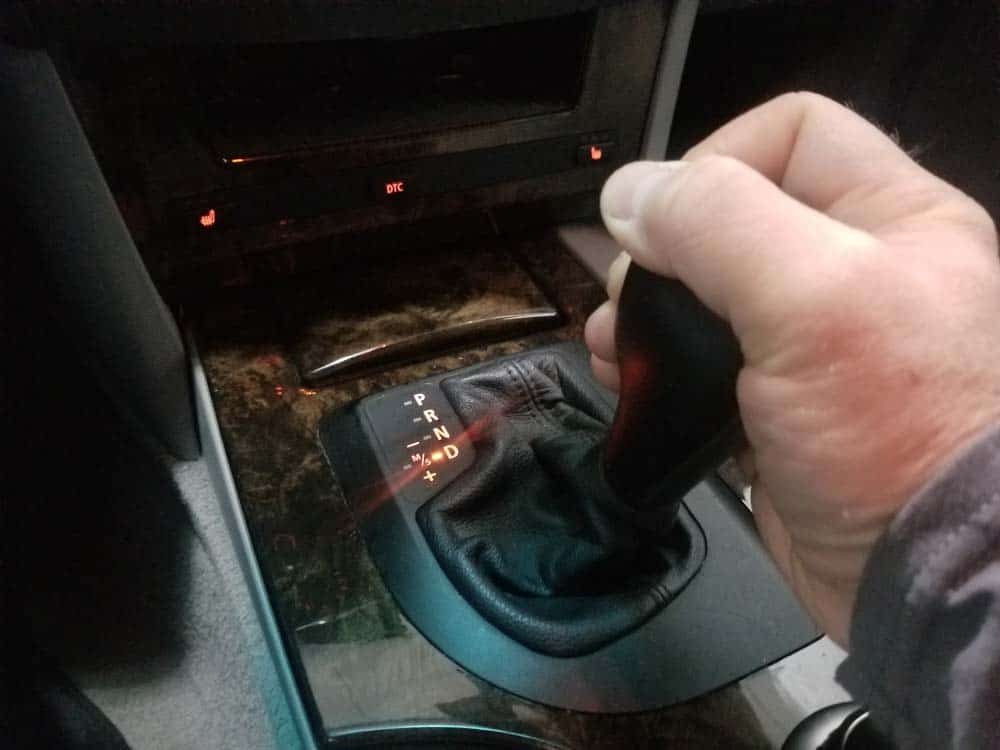
- When the diagnostic scanner shows the transmission fluid at 100 degrees Fahrenheit leave the engine running with the transmission in park and proceed to the transmission for the final fill.
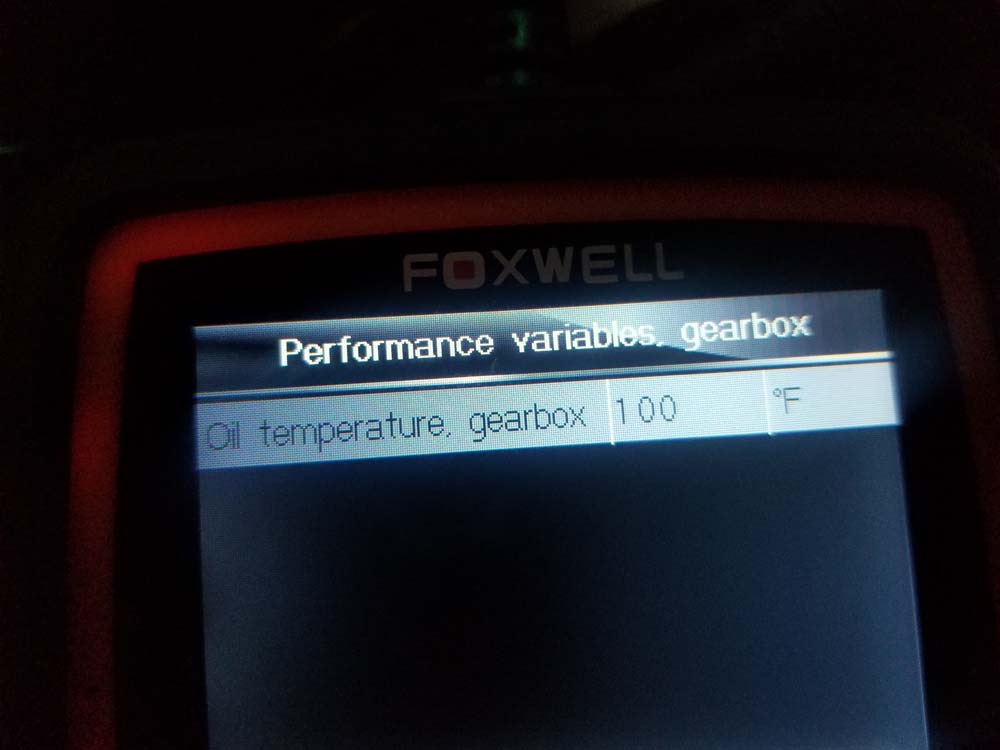
- Remove the fill plug on the transmission. Add transmission fluid until it flows out of the drain hole. The transmission is now properly filled.
- Replace the fill plug and torque to 32 Nm (24 ft-lb).
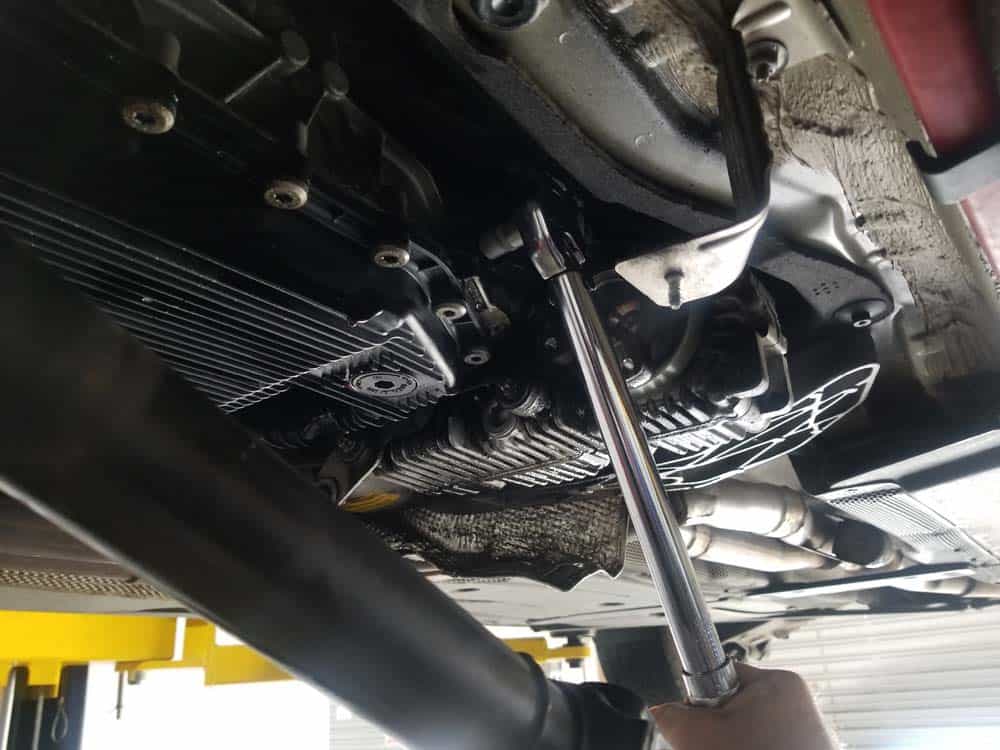
- With the vehicle still running, check for any leaks in the oil pan gasket. If you see any visible leaks, use you T40 torx socket to snug up the mounting bolts (no more than 1/8 of a turn).
- xDrive models - Turn off the engine. Reinstall the front driveshaft to the transfer case. Torque the mounting bolts to 20 Nm (15 ft-lb).
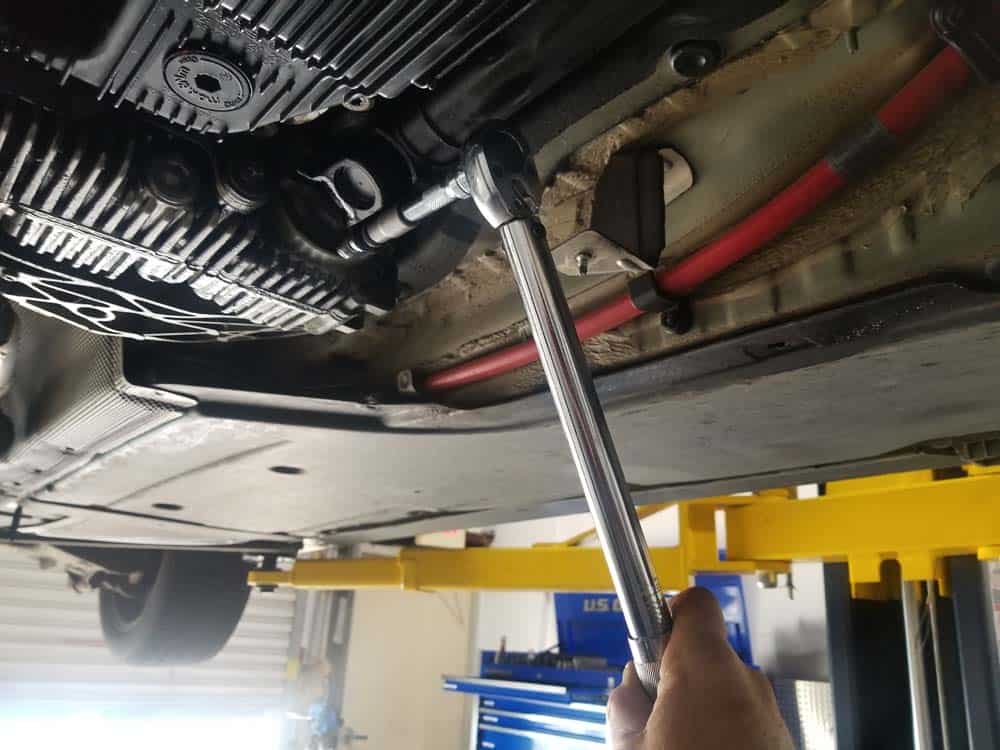
- Replace the front and rear belly pans and lower the vehicle.
- Plug your BMW diagnostic scanner into the OBD-II port and start the vehicle.
- Depending on which scanner you have, you will need to get to the screen that allows you to reset the transmission's adaptations. Every scanner is different...the following images show how to do it on the Schwaben/Foxwell scanner.
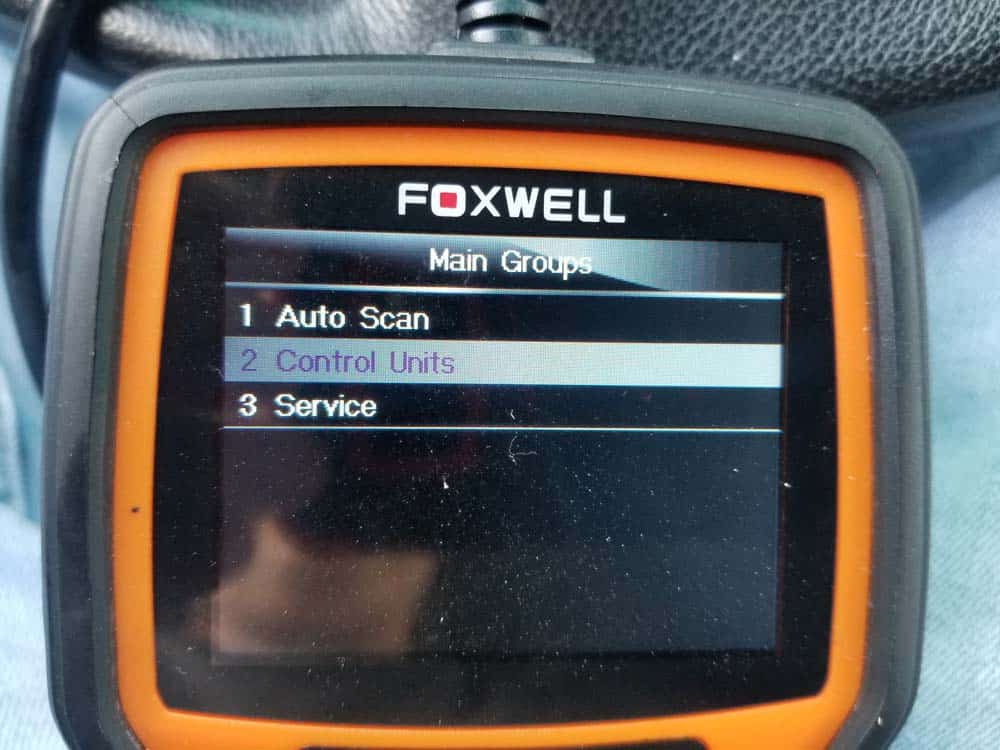
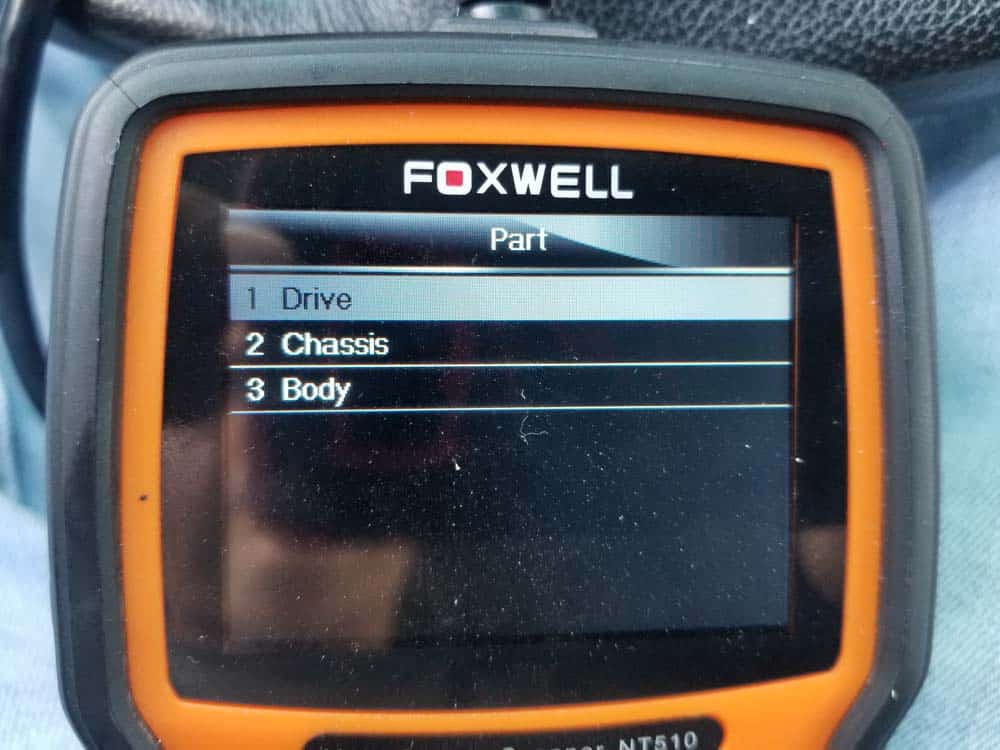
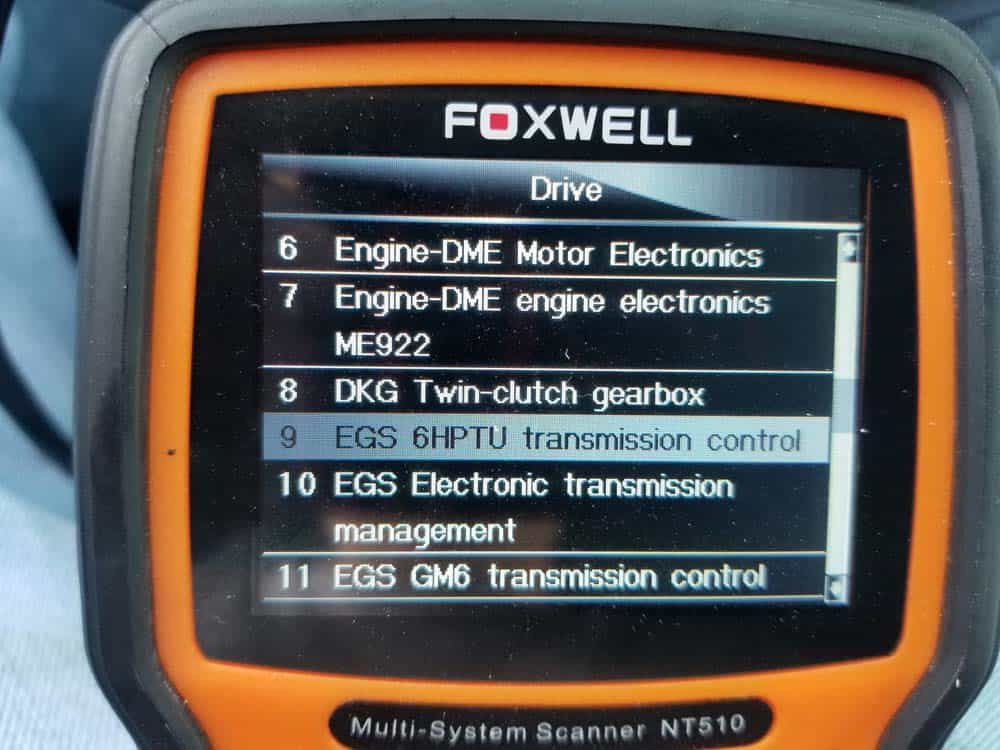
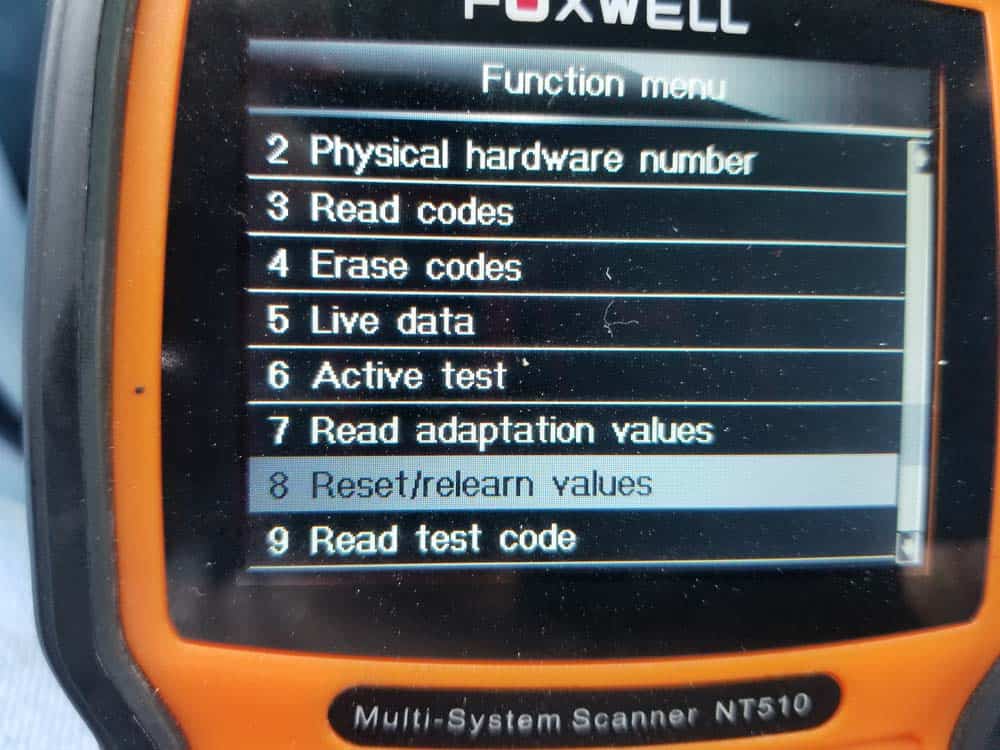
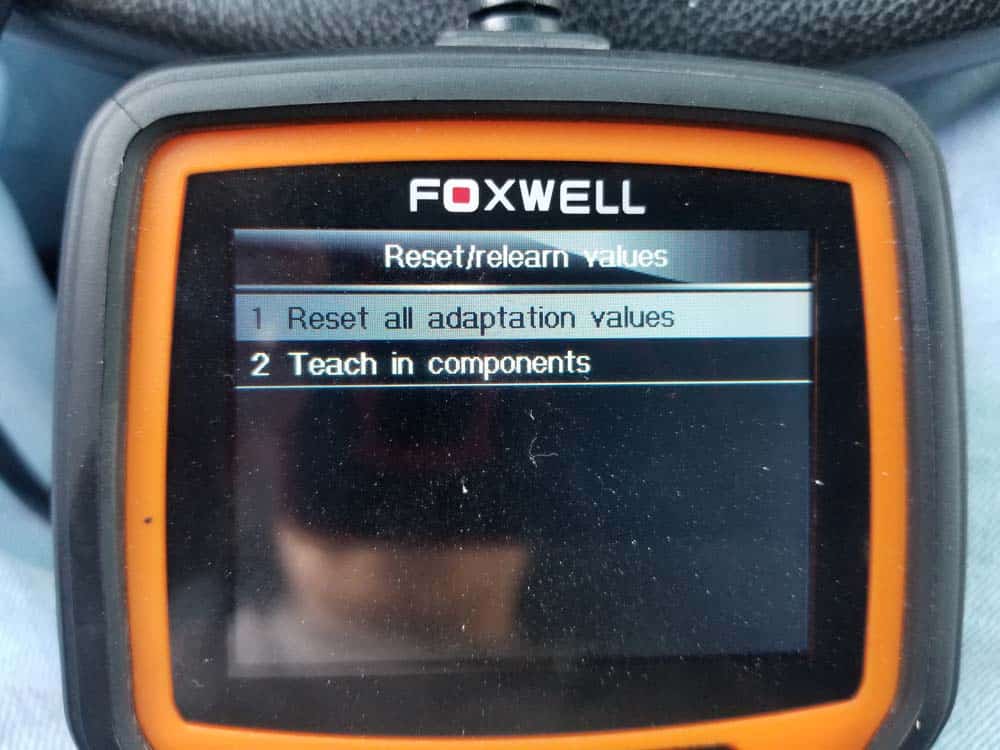
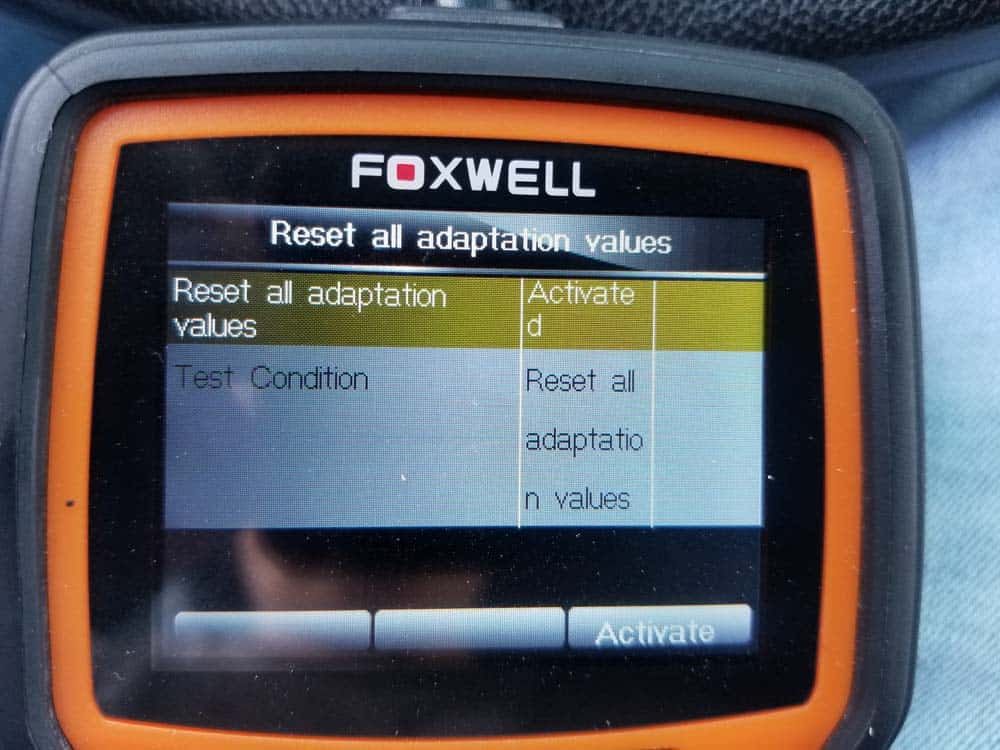
- After the adaptations are reset, turn off the car and remove the key. You are now finished and can drive the vehicle.
Section 4 - Reinstalling the Valve Body onto the Transmission
It is very important that the valve body and transmission surfaces are thoroughly cleaned with CRC Brakleen before reassembly. Even the slightest amount of debris can keep the valve body sleeves and adapter from properly sealing causing shifting issues. If you have not replaced your valve body sleeves and adapter, we strongly suggest you read our article on how to do it now.Section 5 - Replacing the Oil Pan
Once you have successfully completed the BMW transmission solenoid replacement, the next step is to replace the oil pan.Section 6 - Refilling the 6HP19X Transmission with Fluid
Refilling the BMW 6HP19X six speed transmission is a two step process. First the transmission oil pan must be initially filled. After the initial fill, the transmission must be warmed up to its final fill temperature (100F) before topping off with fluid. Per the manufacturer (ZF) specifications, the vehicle must be running and the transmission in park while topping off the transmission - topping of the transmission with the engine off could cause an under filled transmission. Section 7 - Resetting the Transmissions Adapation Values
It is very important that at the end of any service work or repair to the ZF six-speed transmission, the gearbox's adaptations are reset. The adaptations are a "learned" code stored in your transmission's computer module that changes the performance of your transmission based on past driving habits and driving conditions. They also make changes based on the wear and tear of internal parts. Not resetting the adaptations after this repair may cause reduced performance in your transmission and potential long-term damage to its internal components. Resetting the adaptations is extremely easy and only takes a couple of minutes. You must have a BMW diagnostic scanner to reset them. Don't have a BMW scanner? You can purchase the same inexpensive scanner we use by clicking here.BMW Transmission Solenoid Replacement Finished

